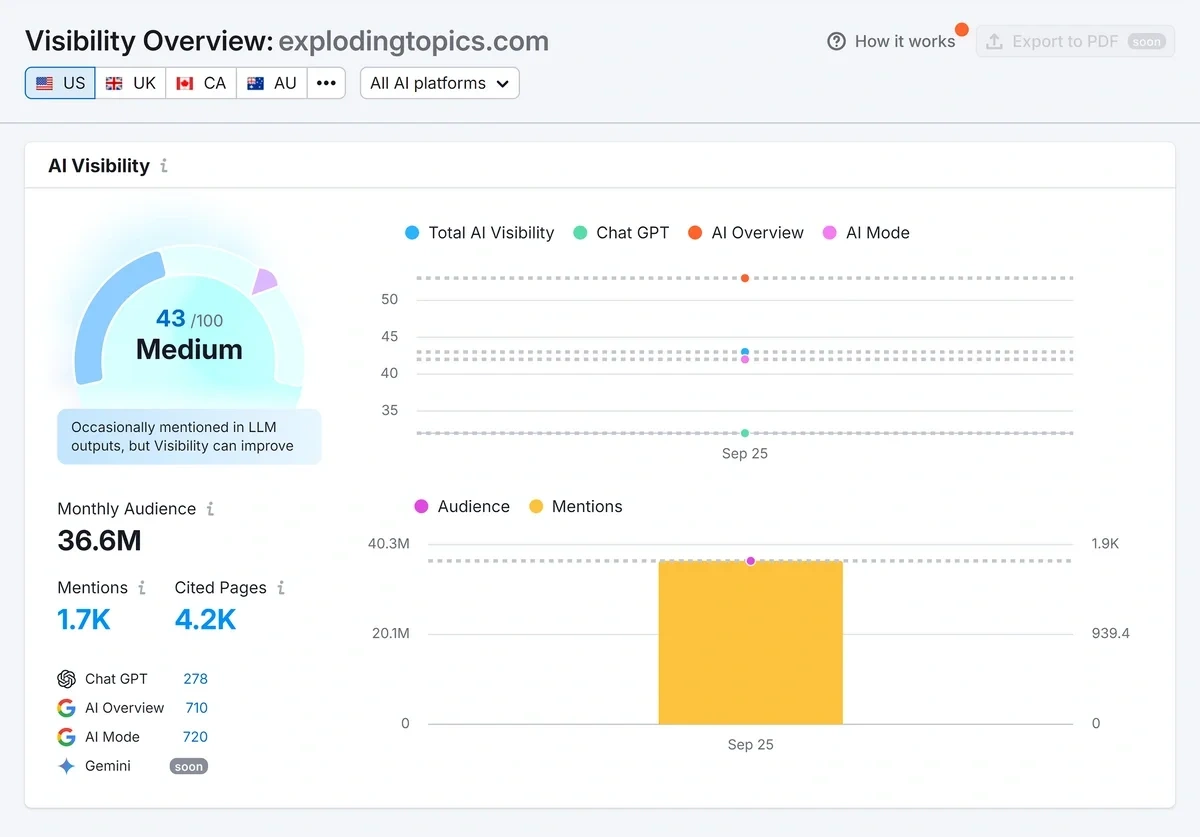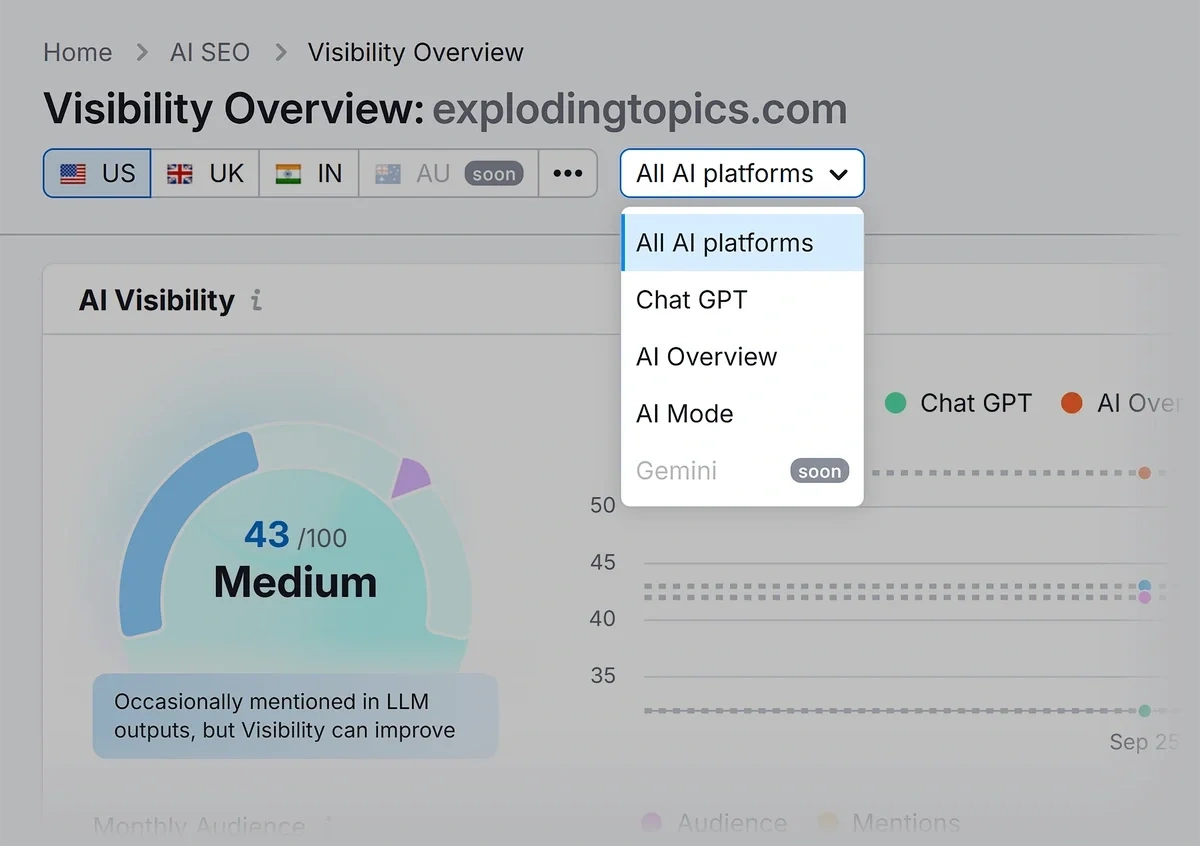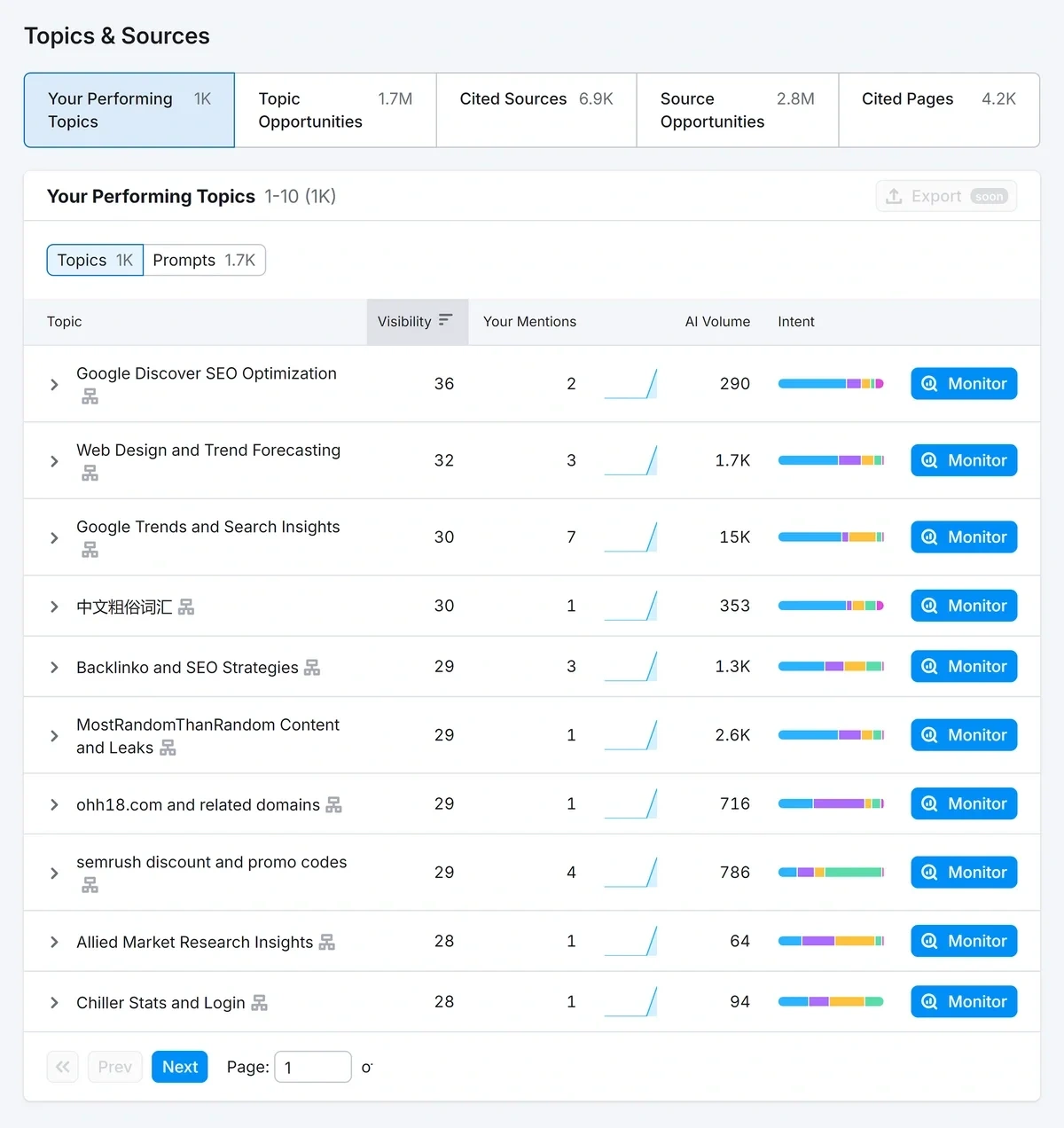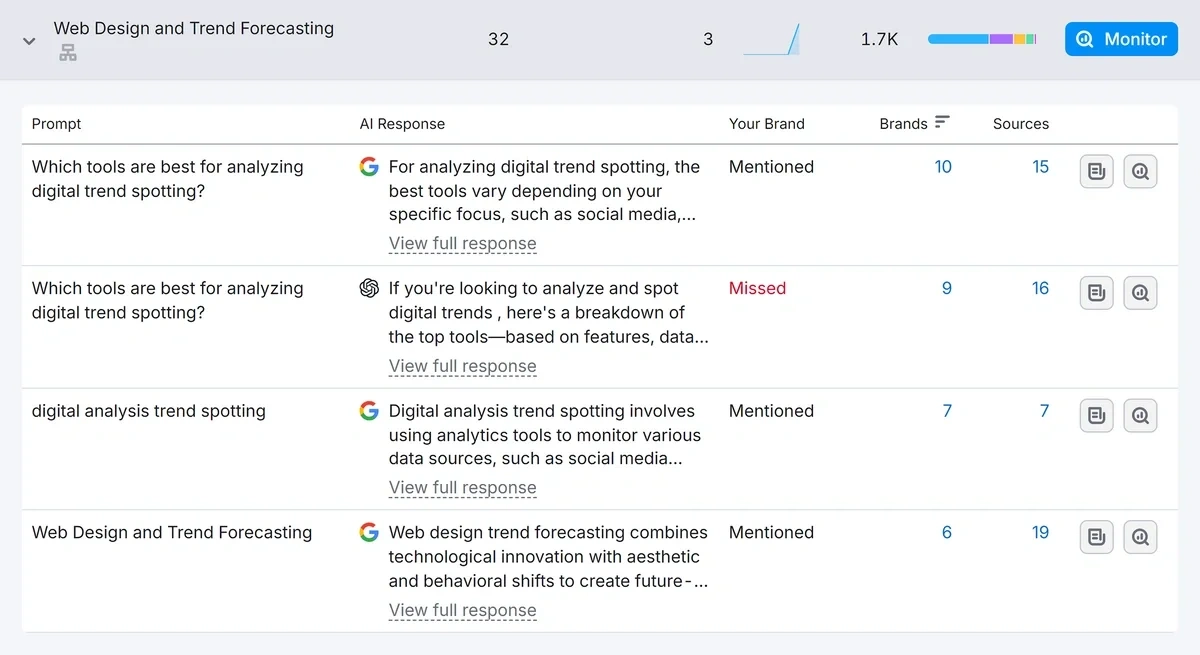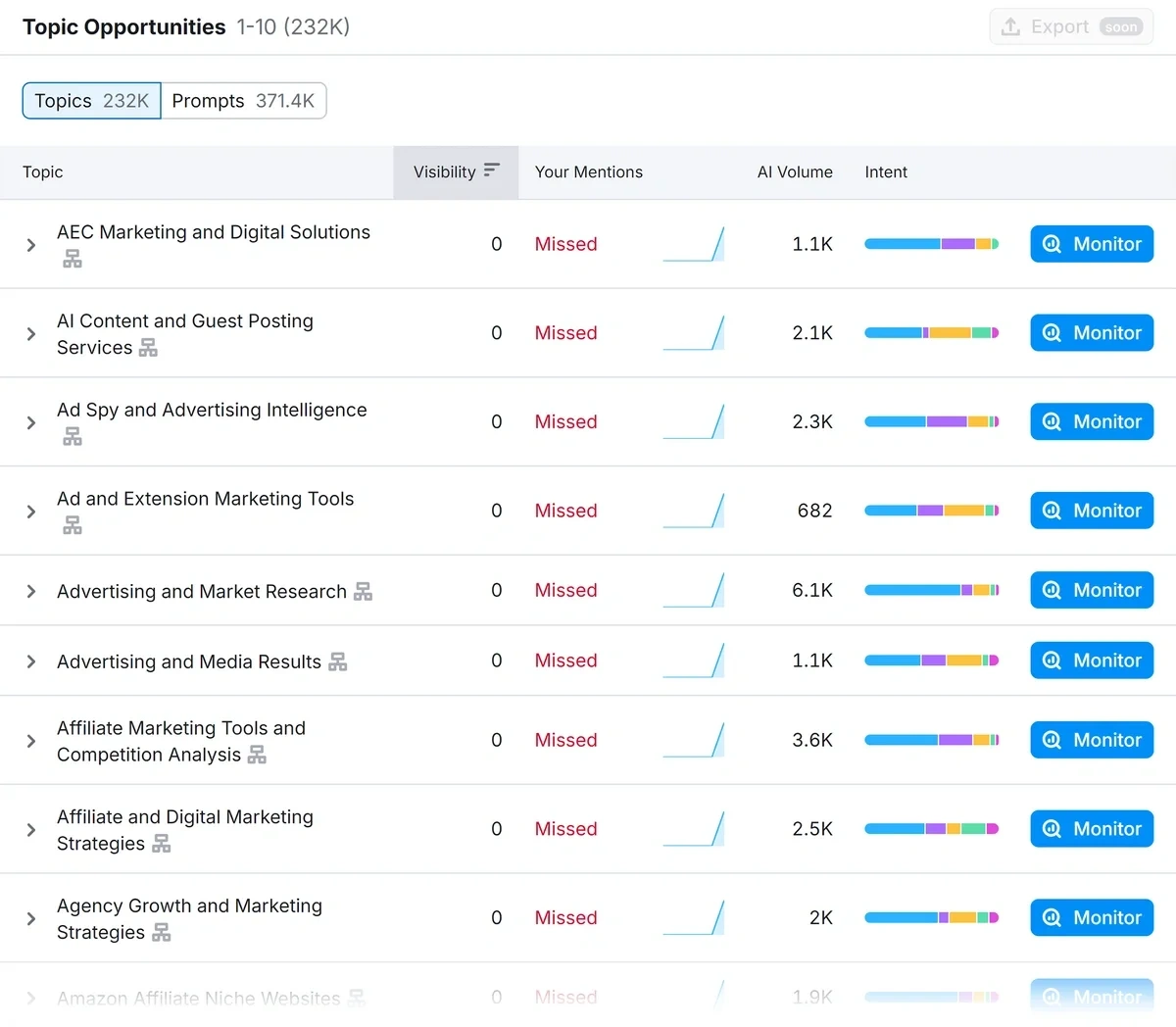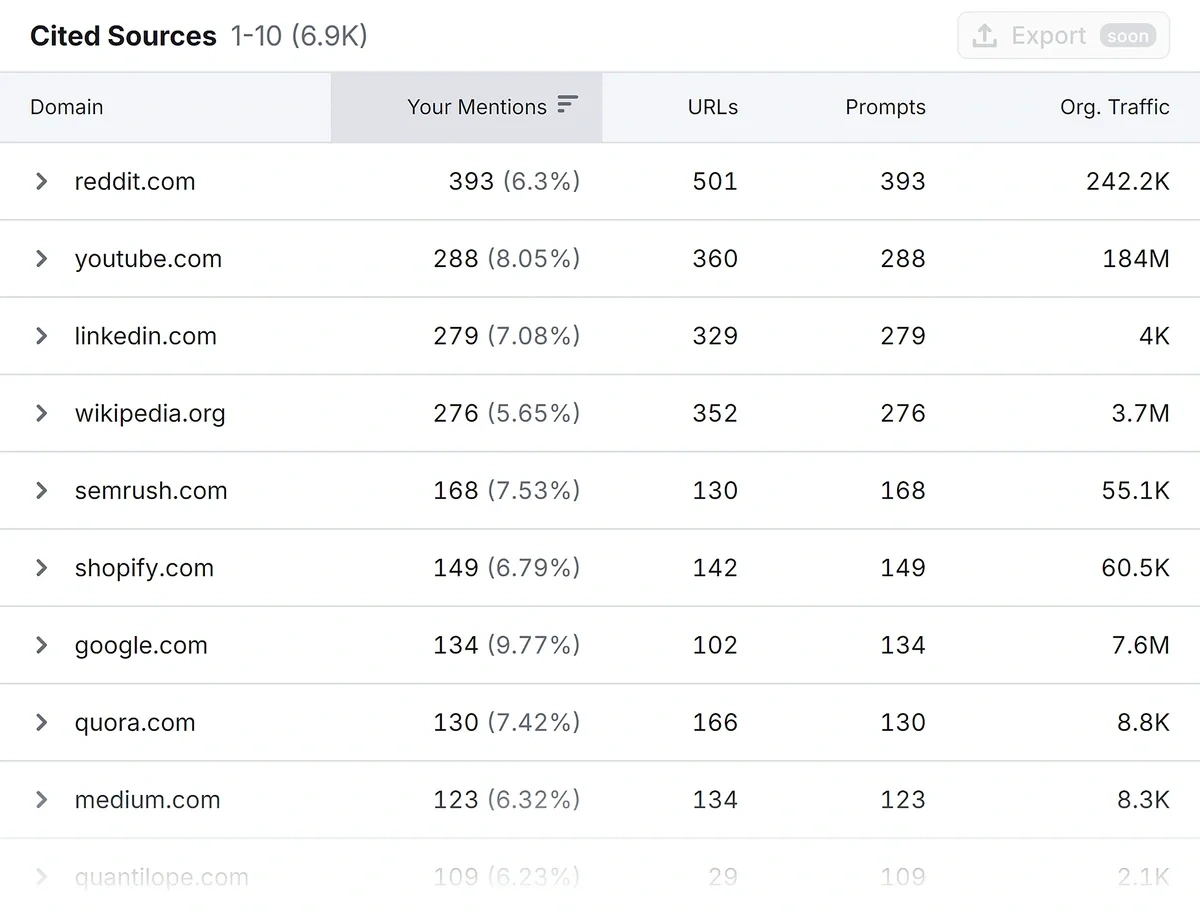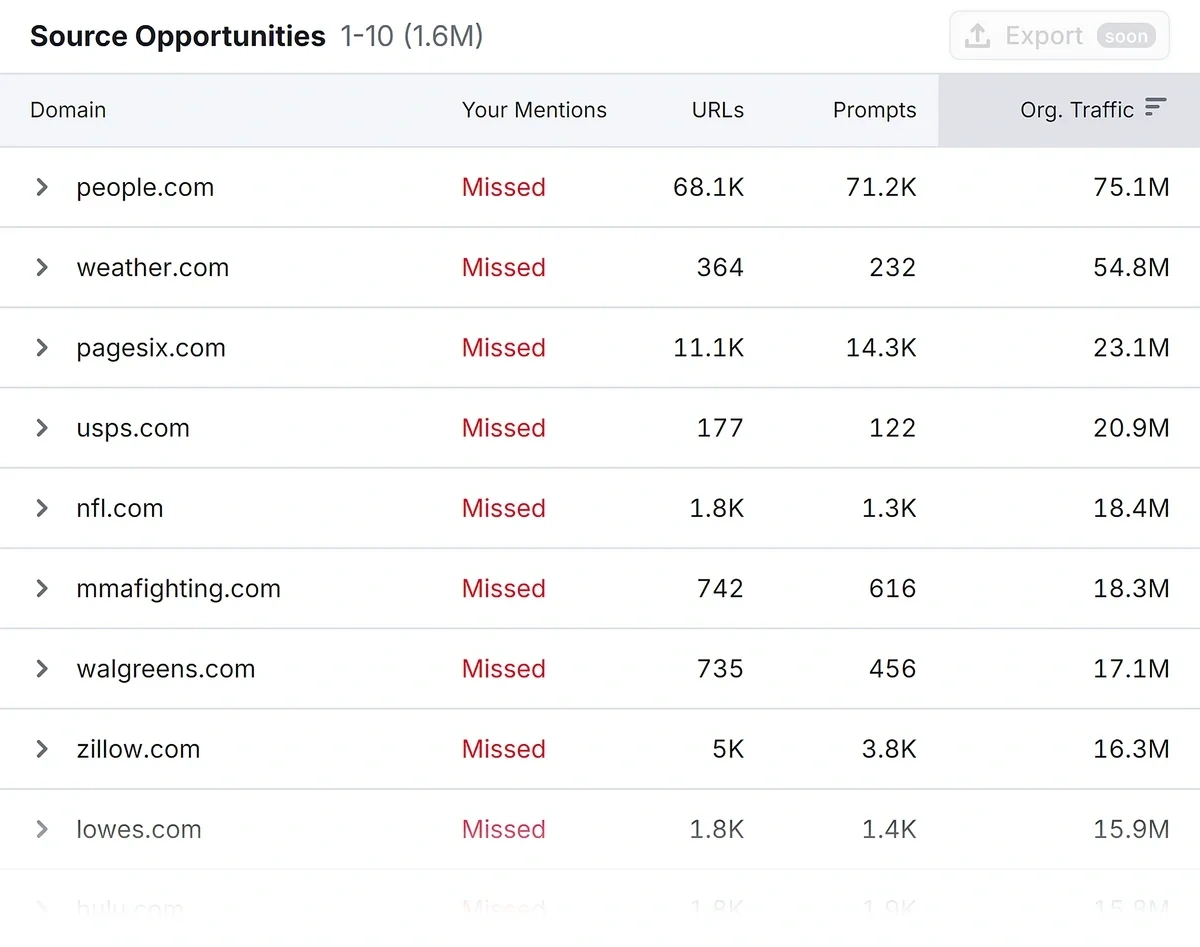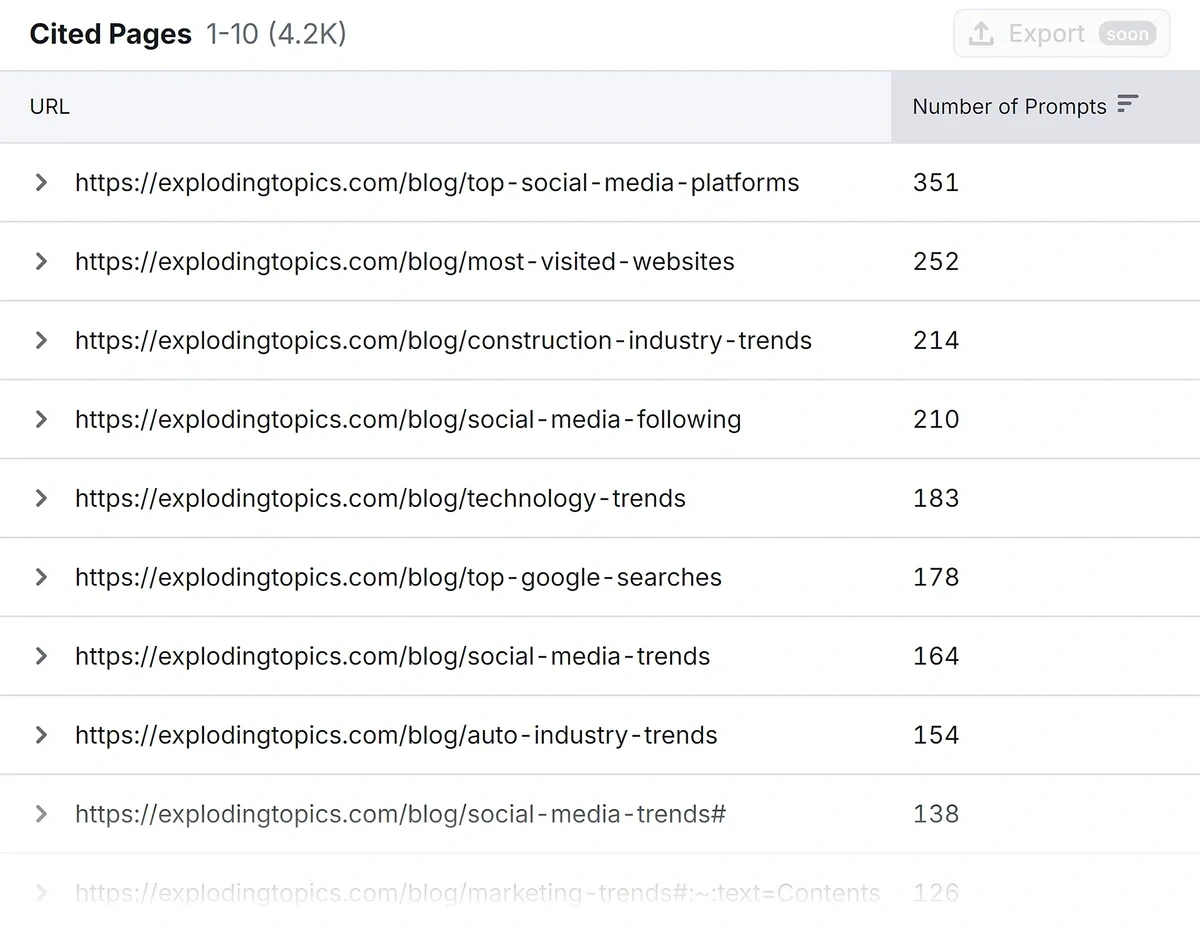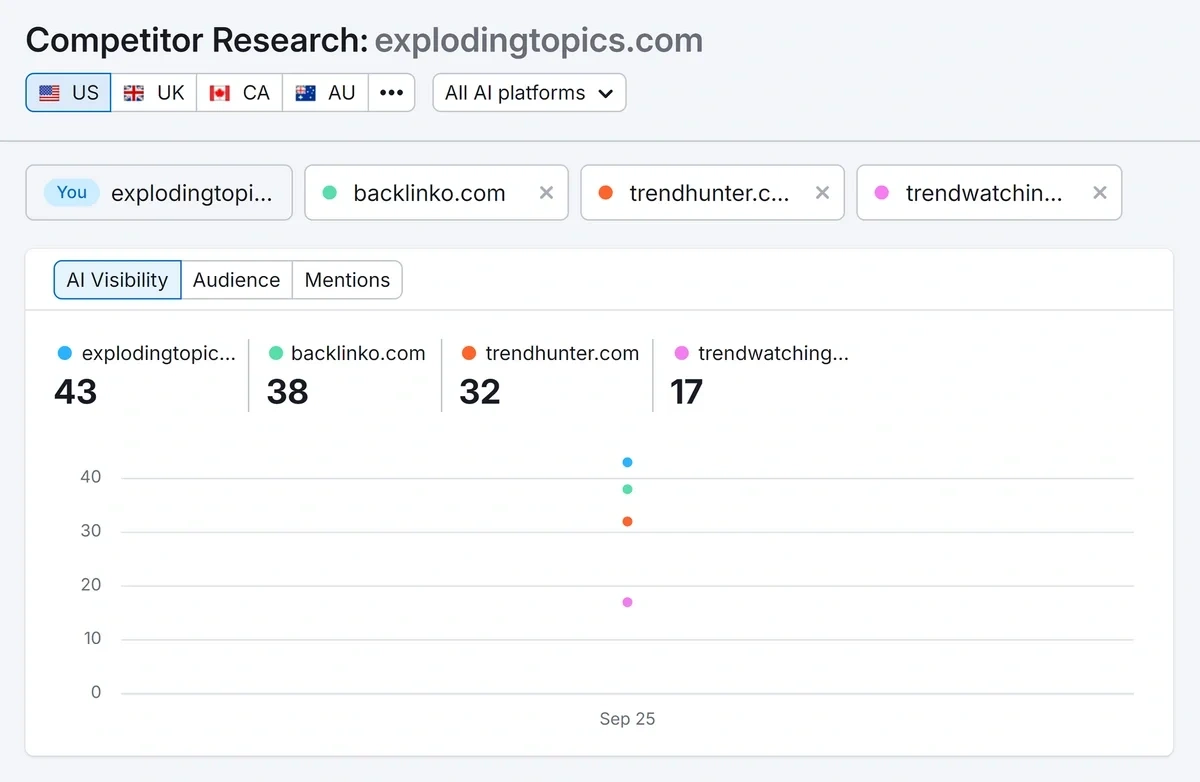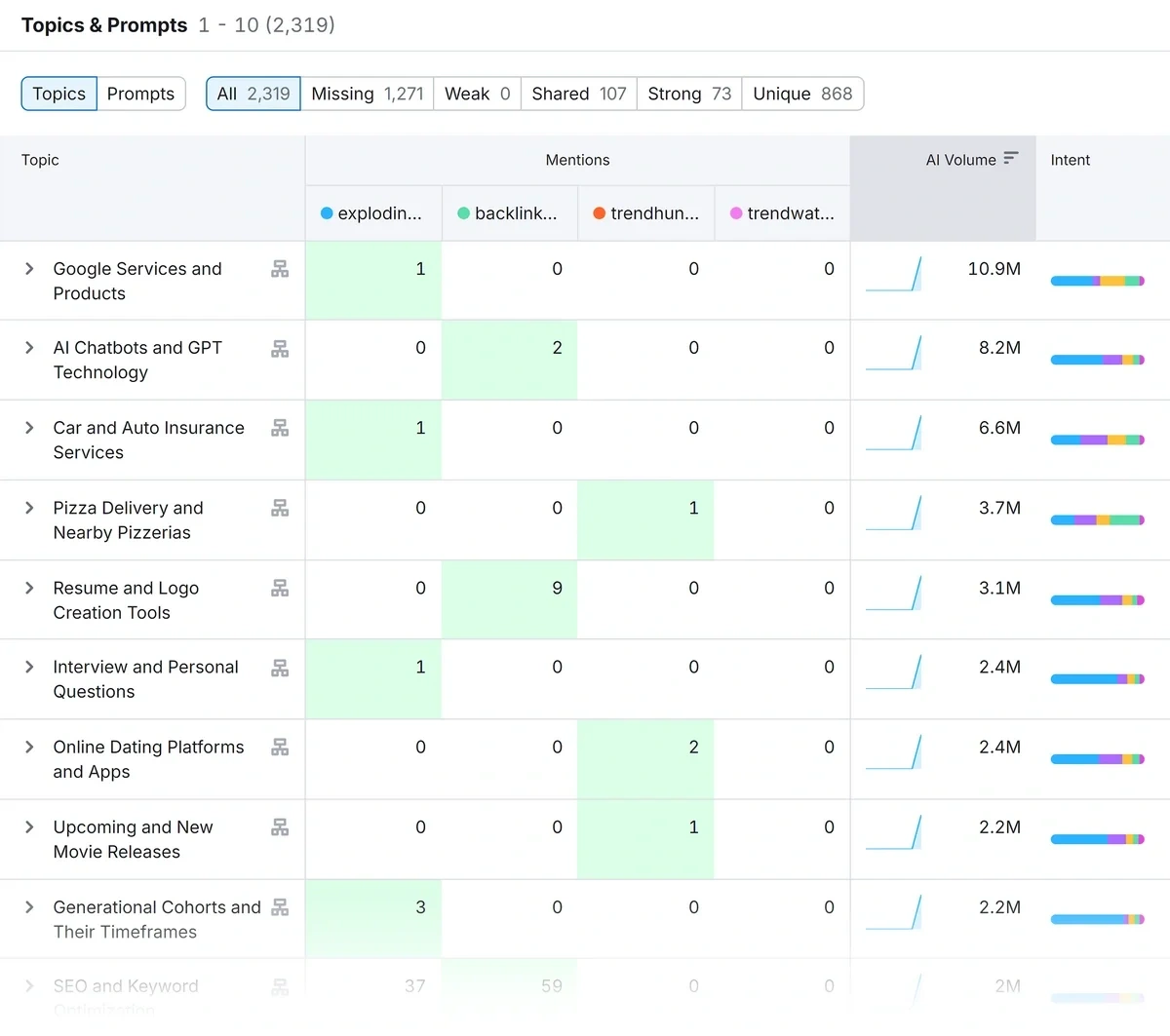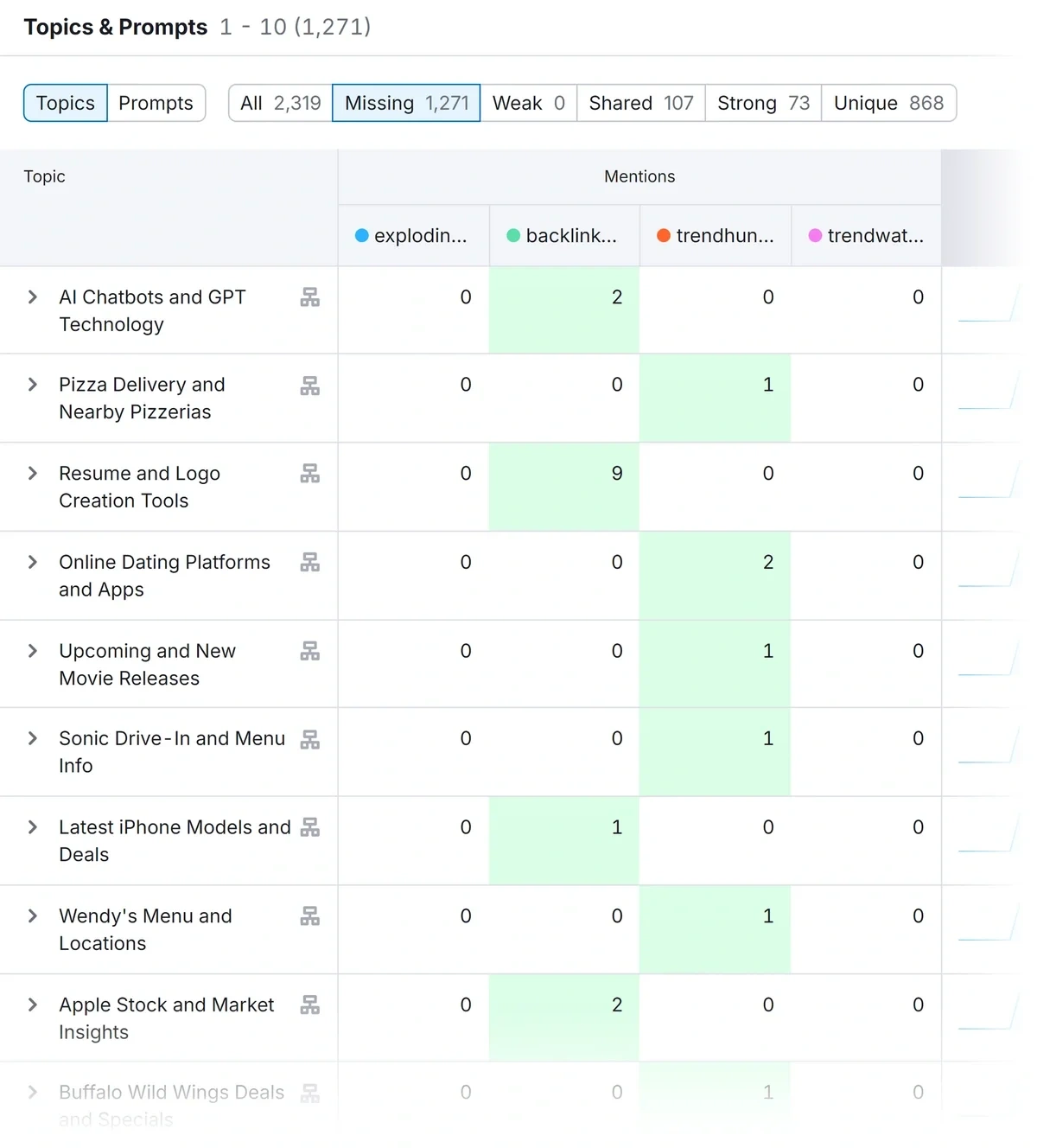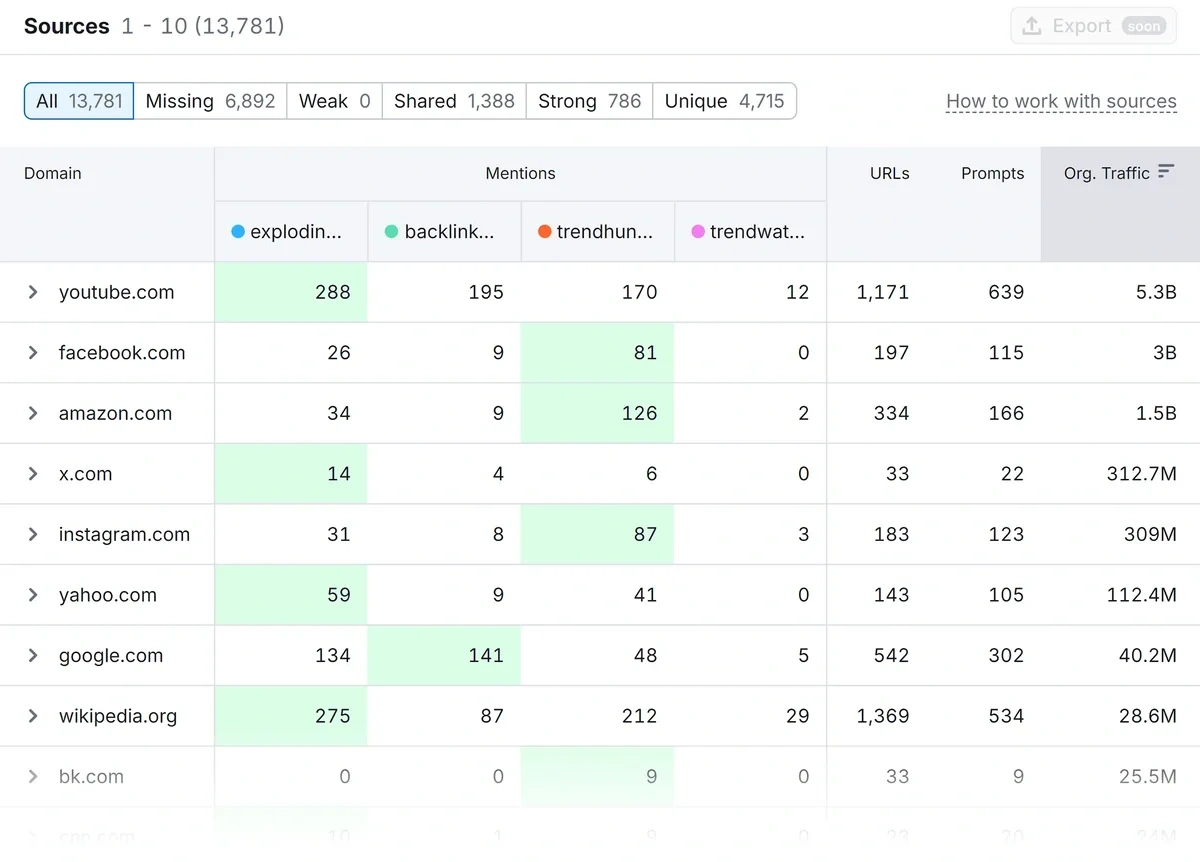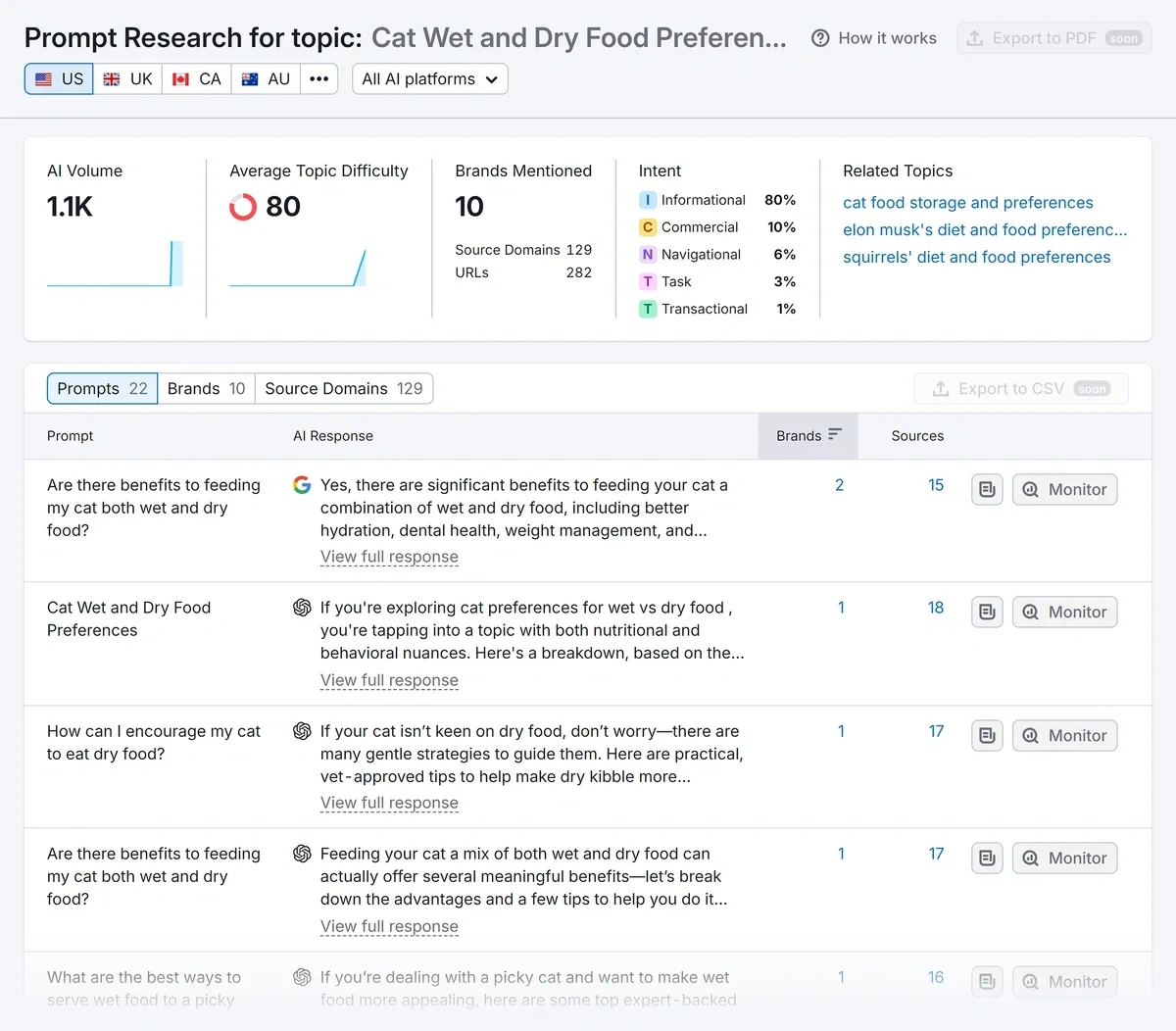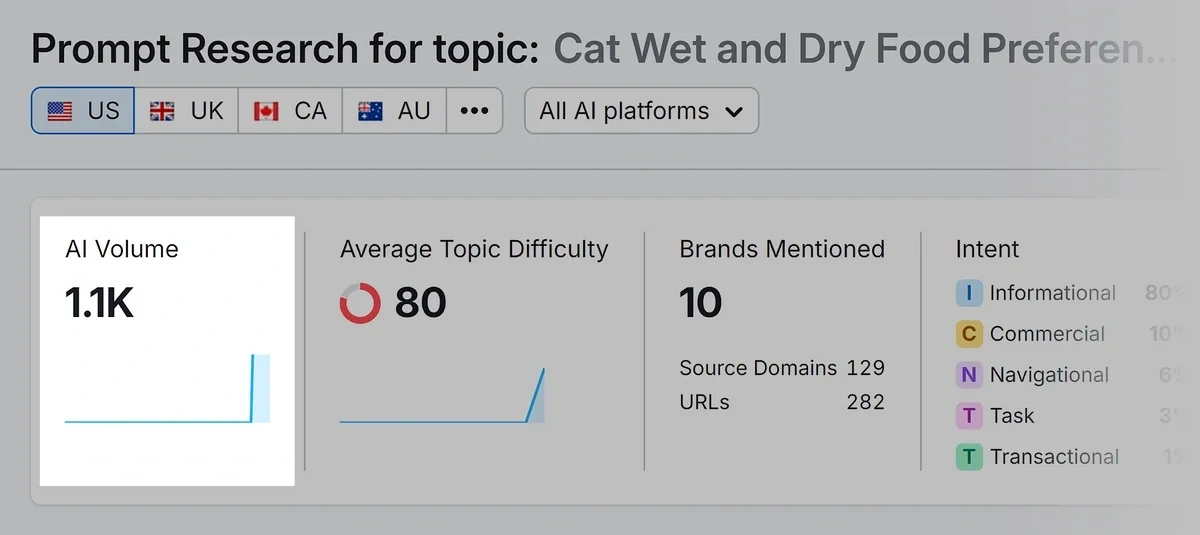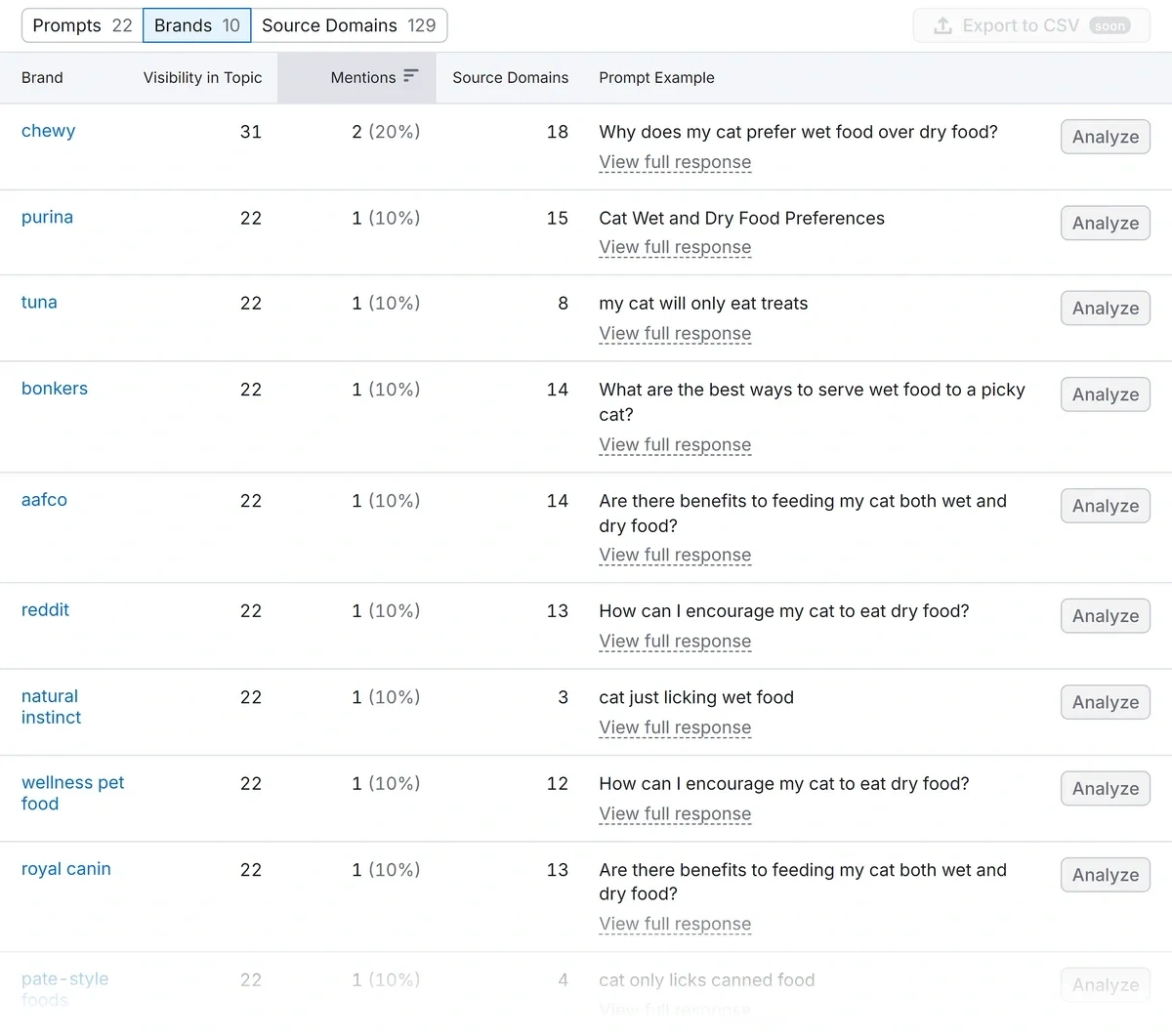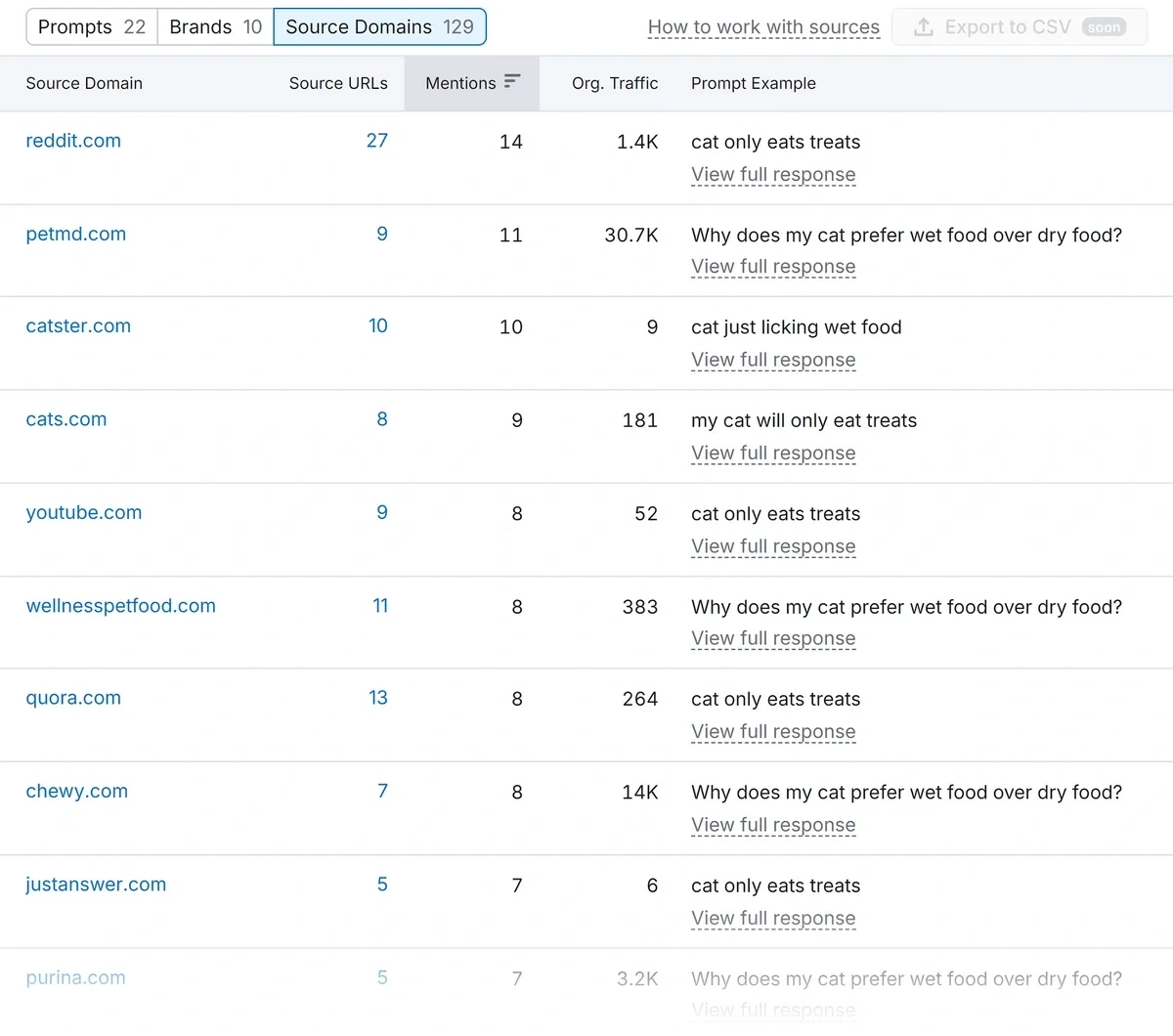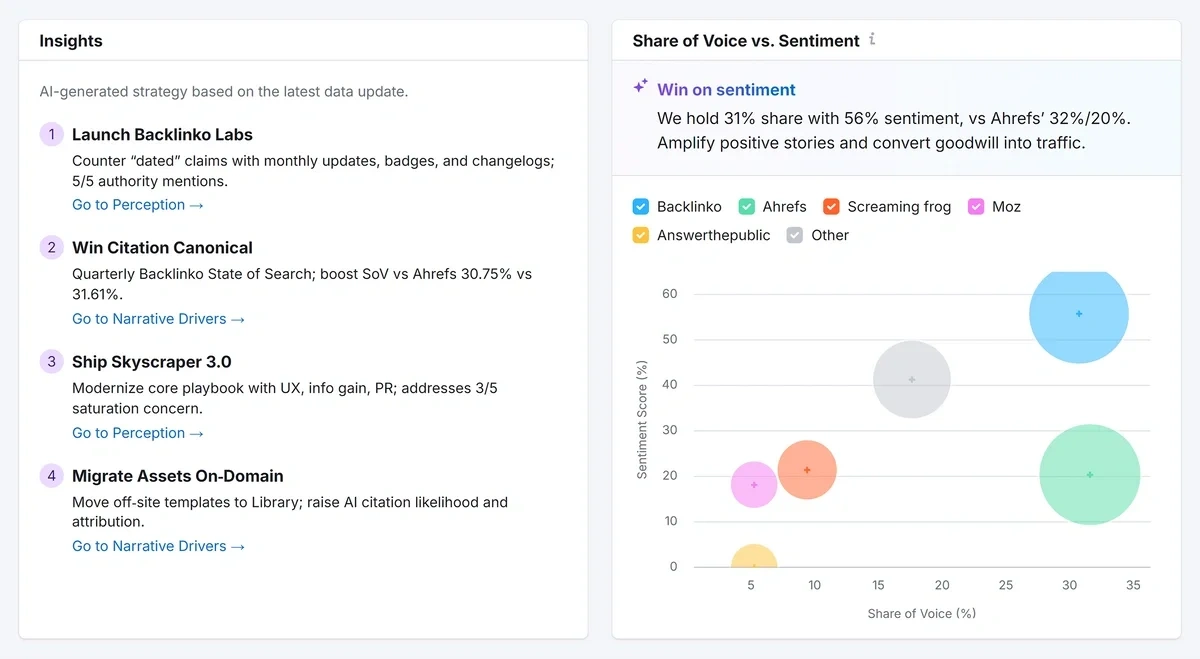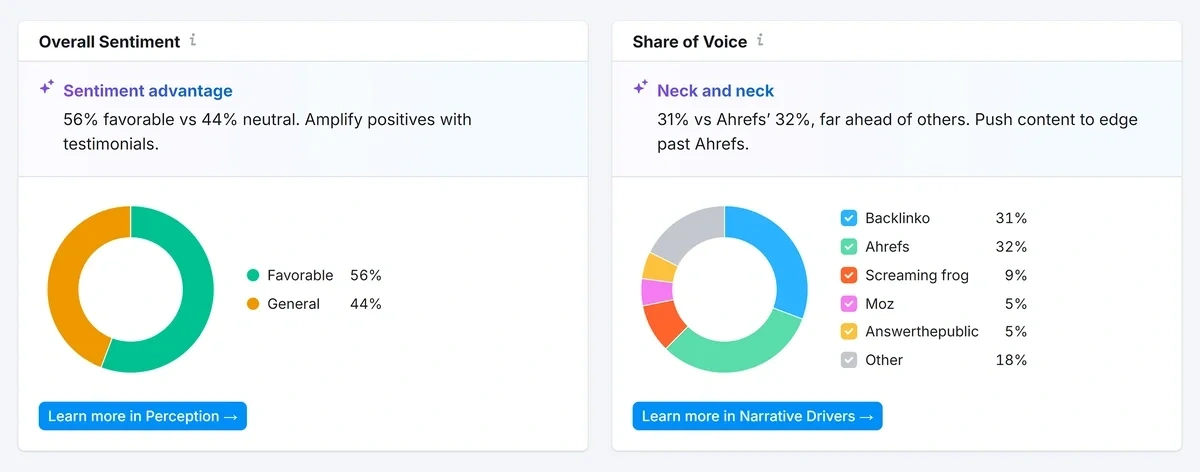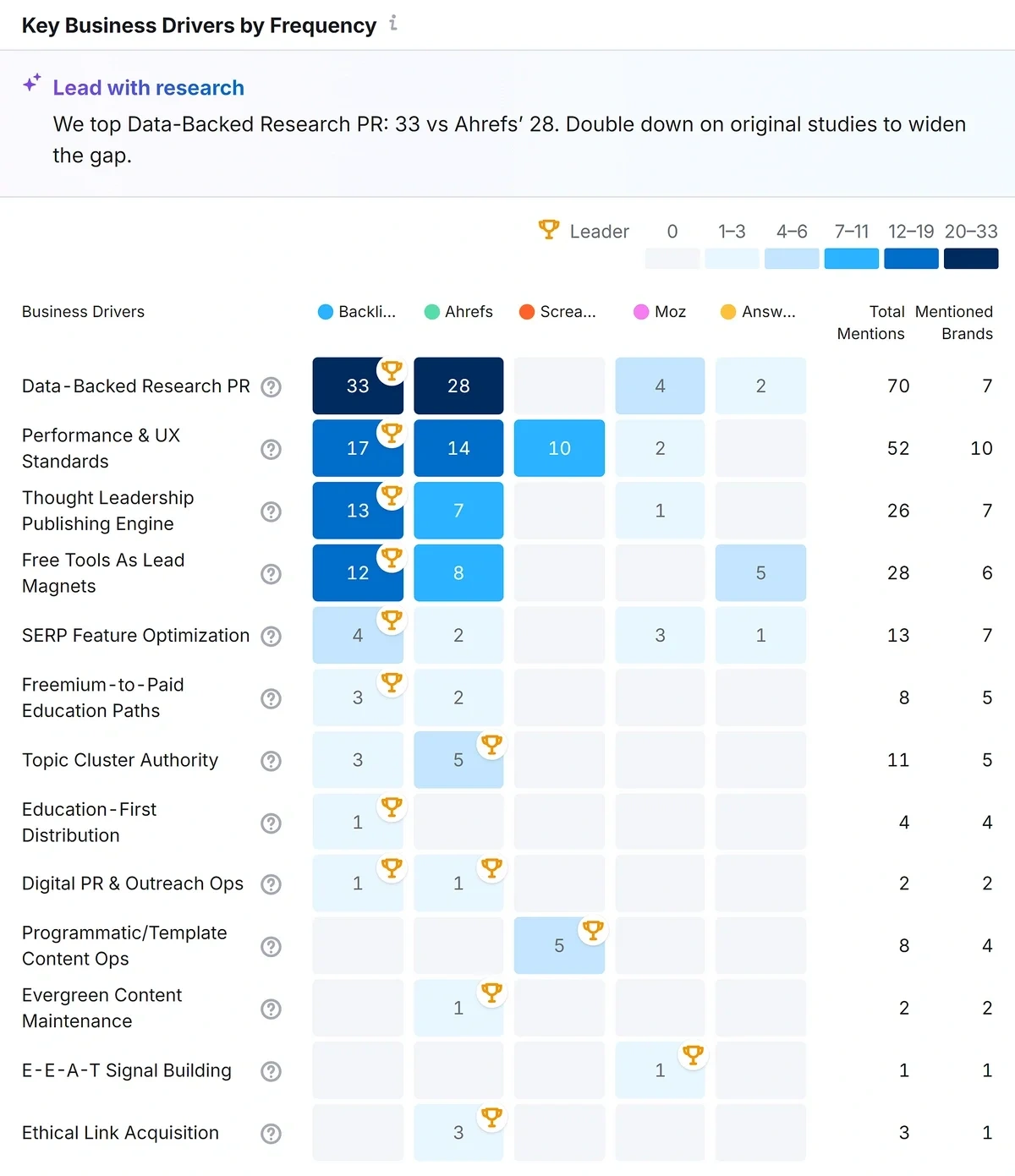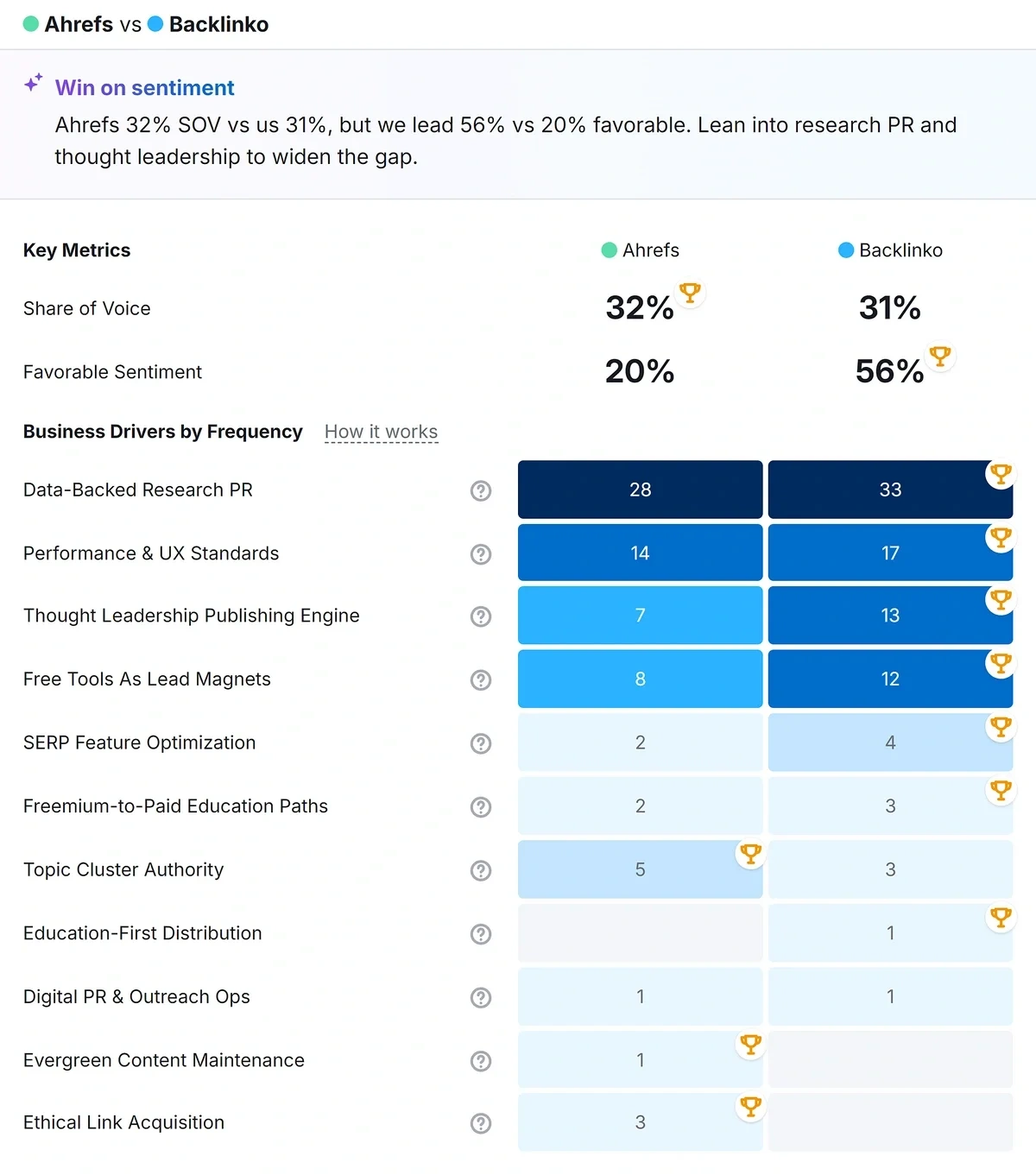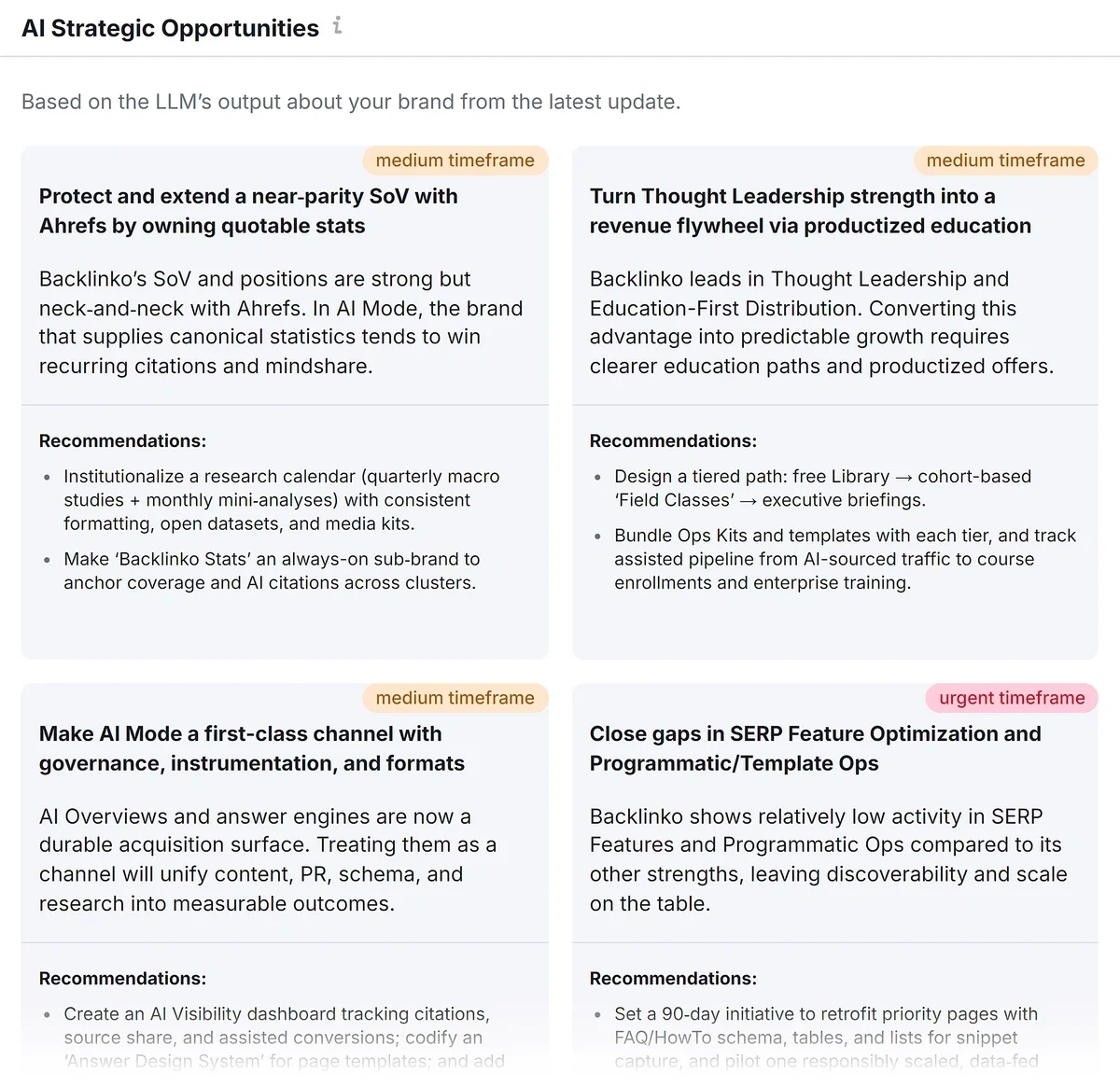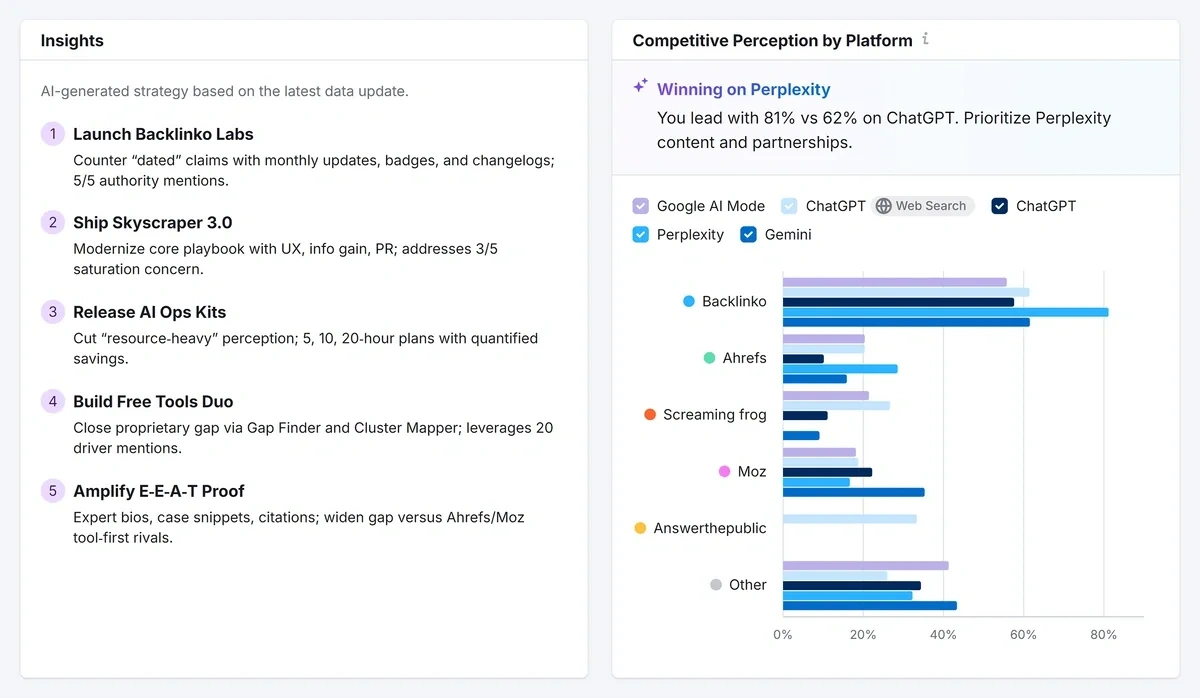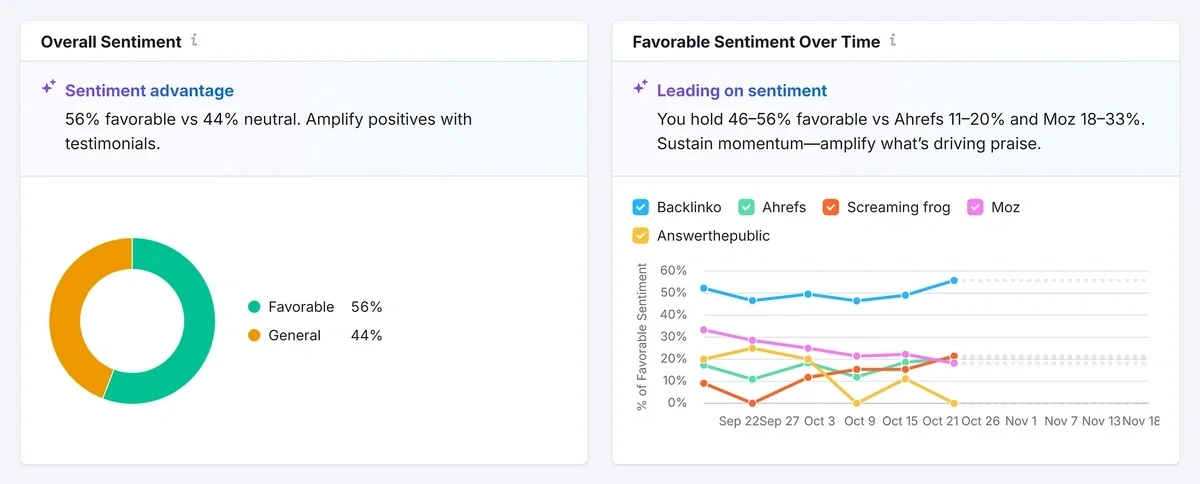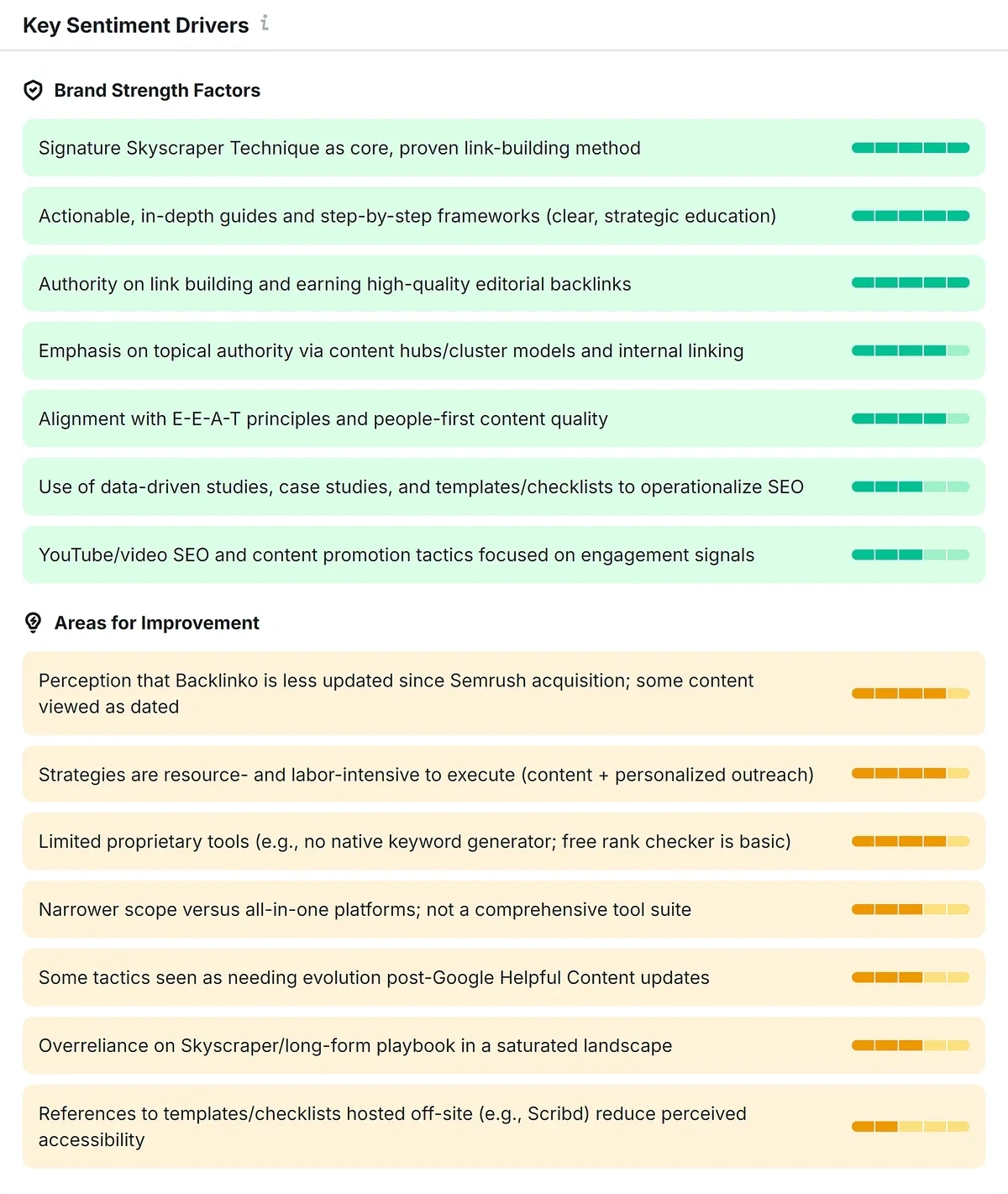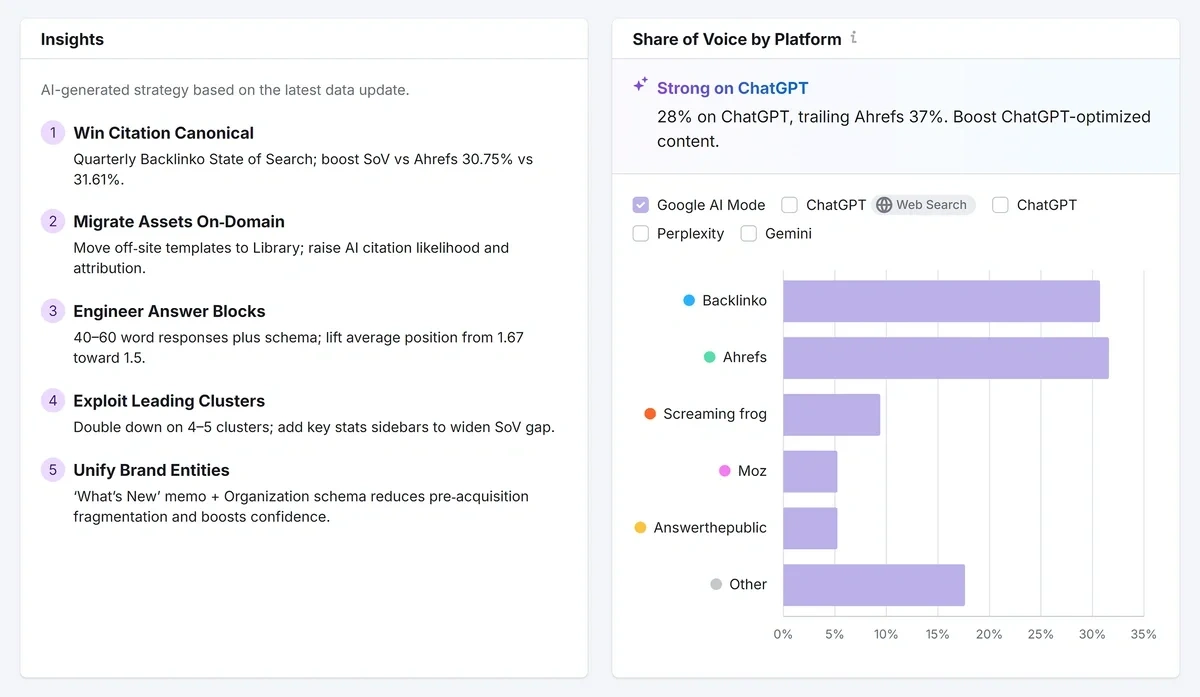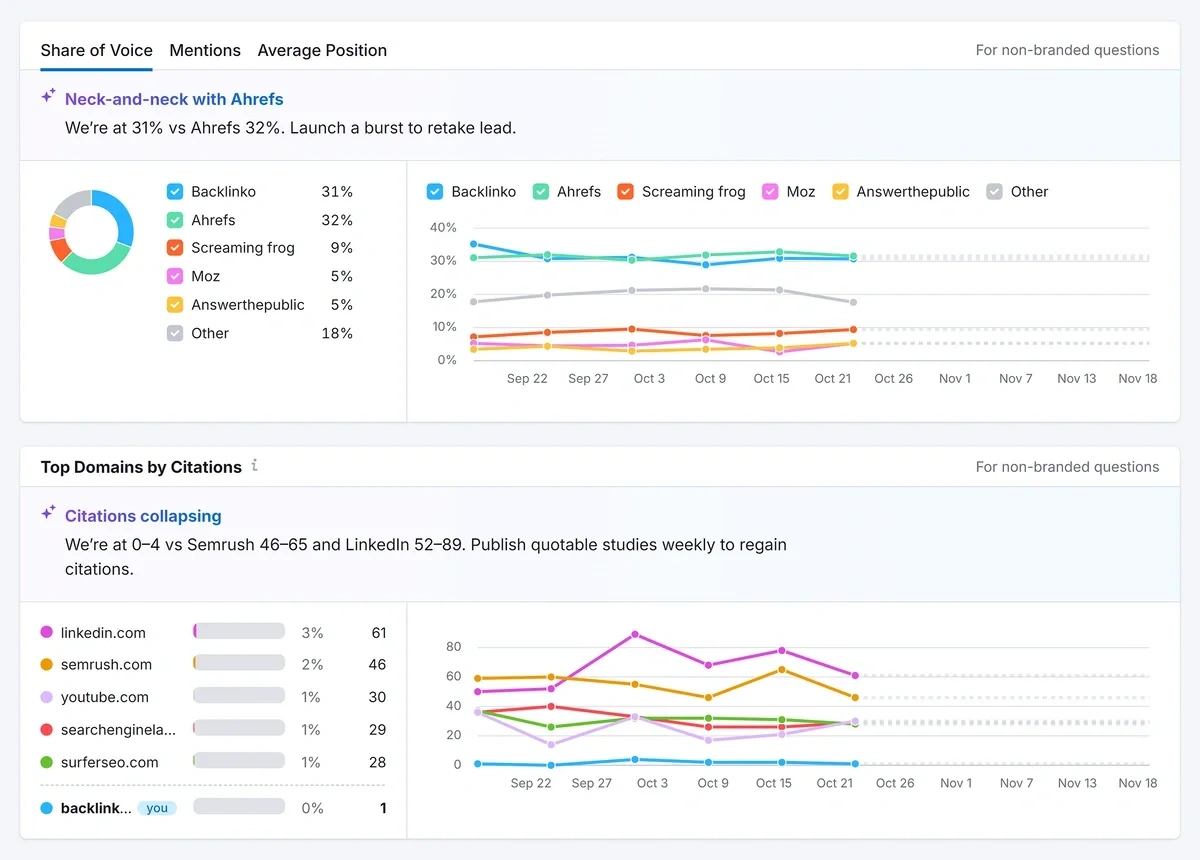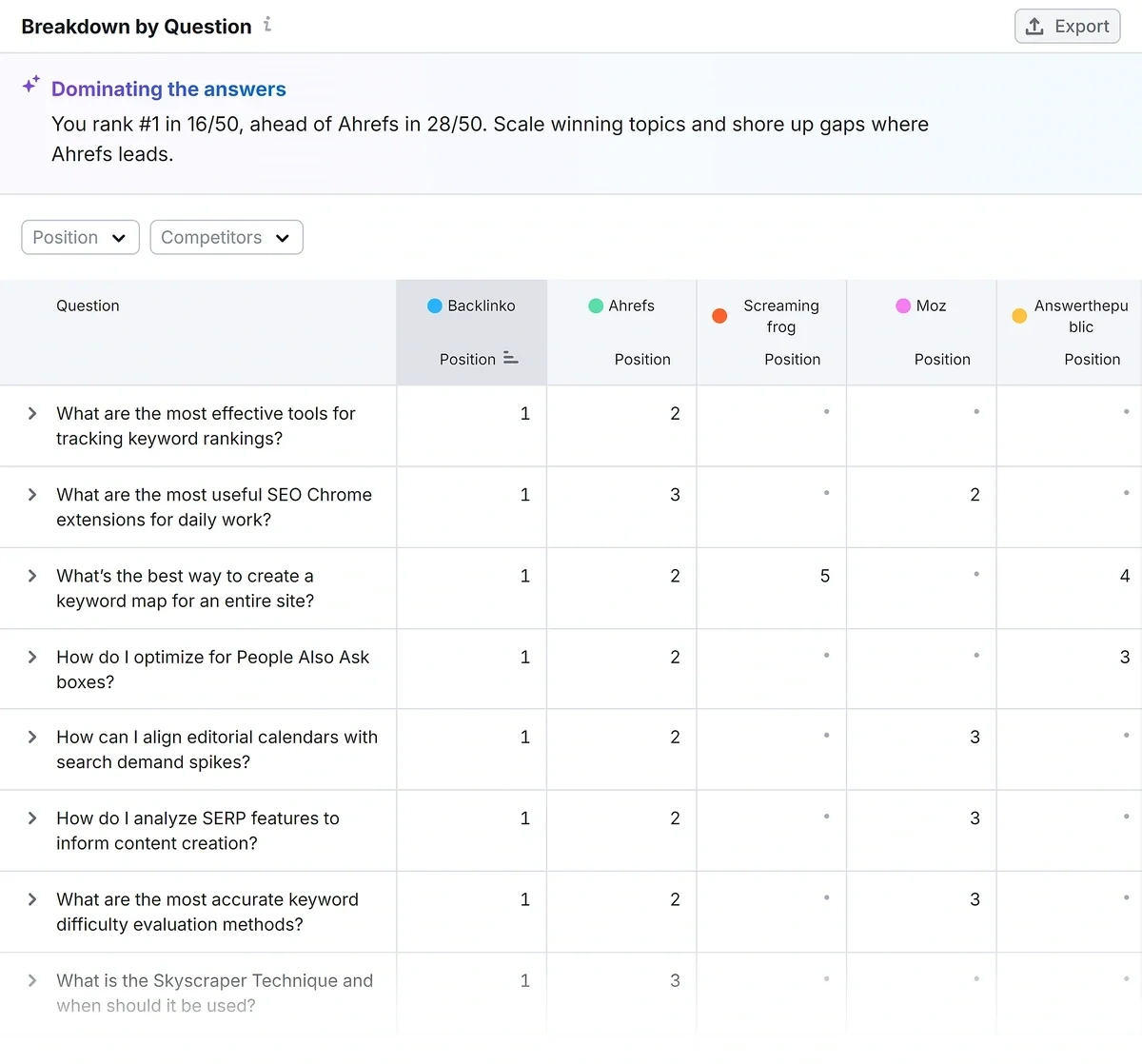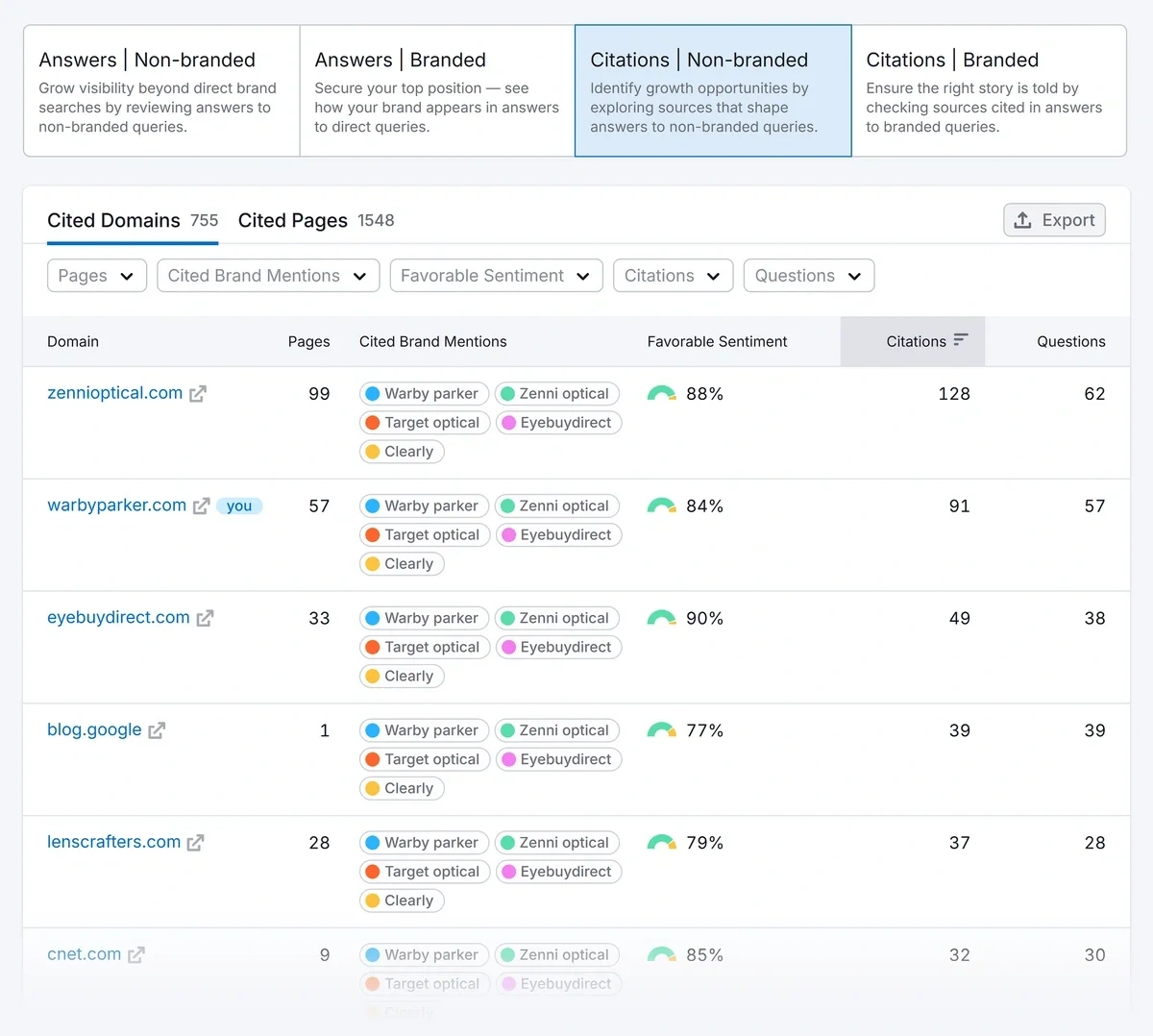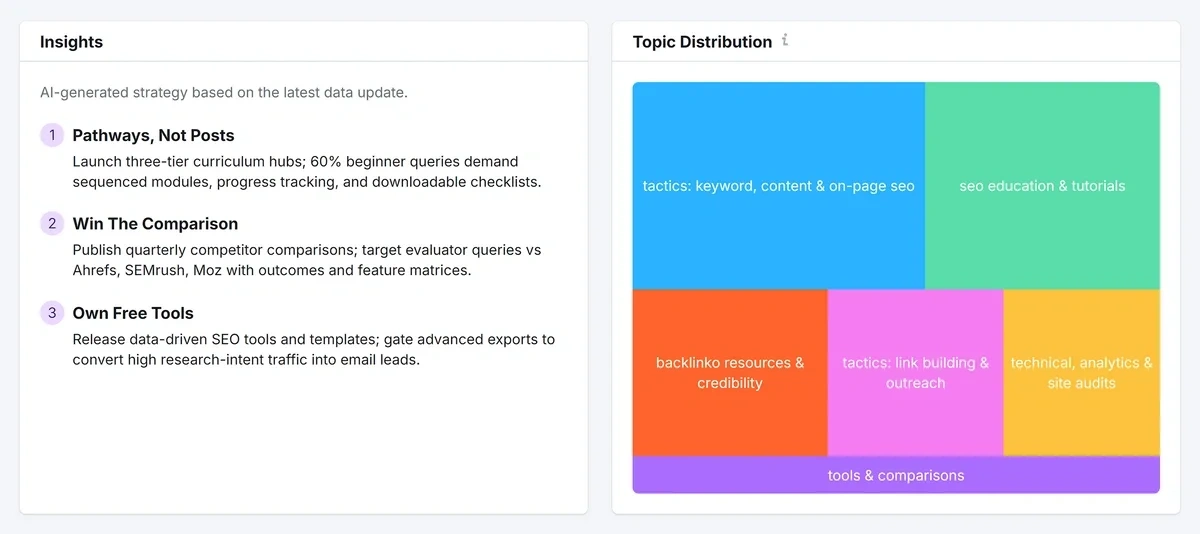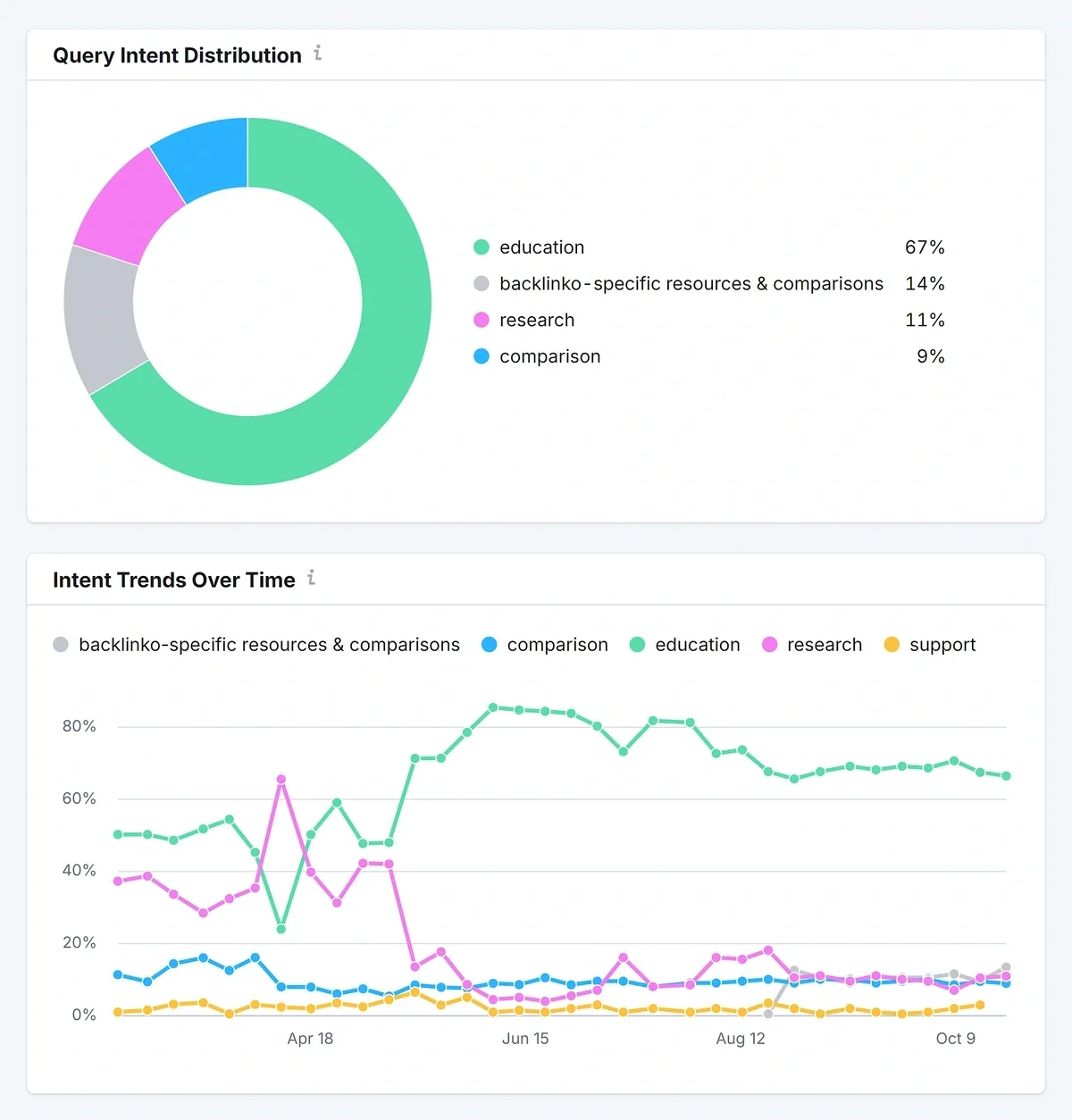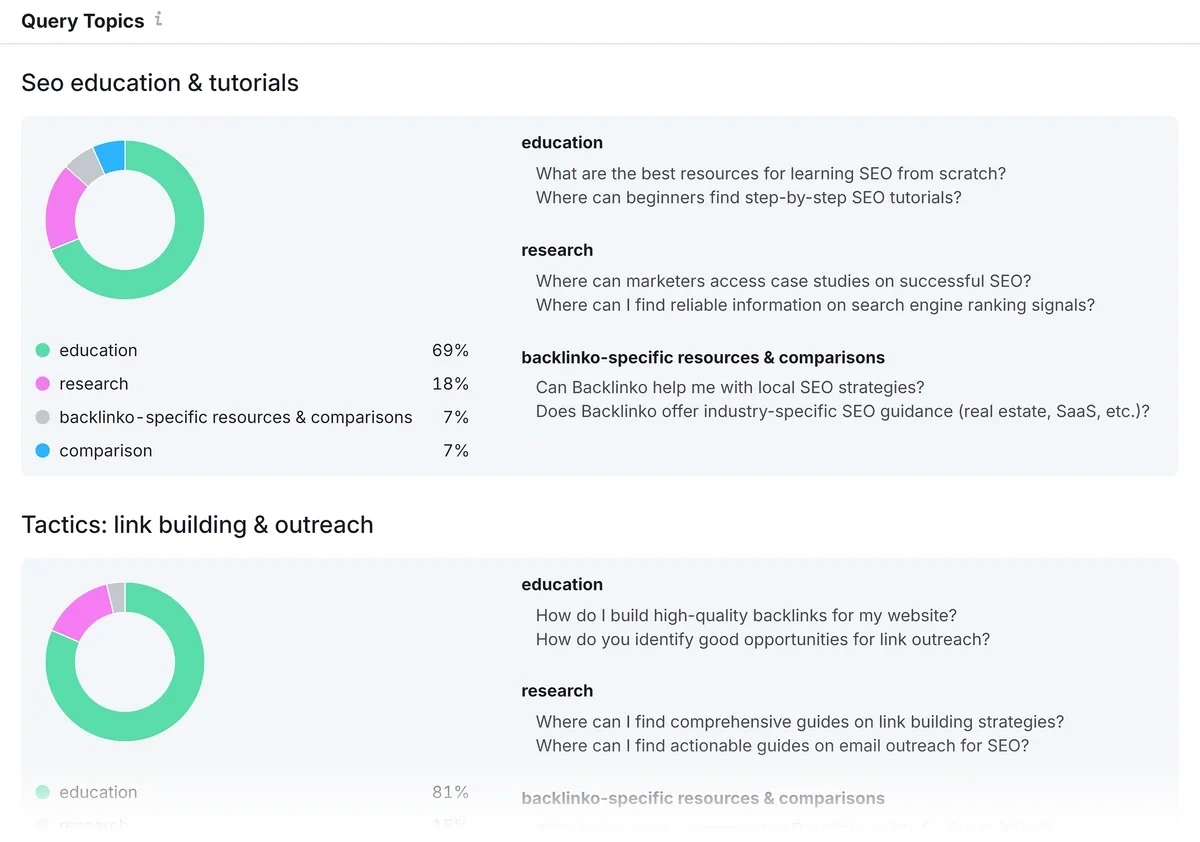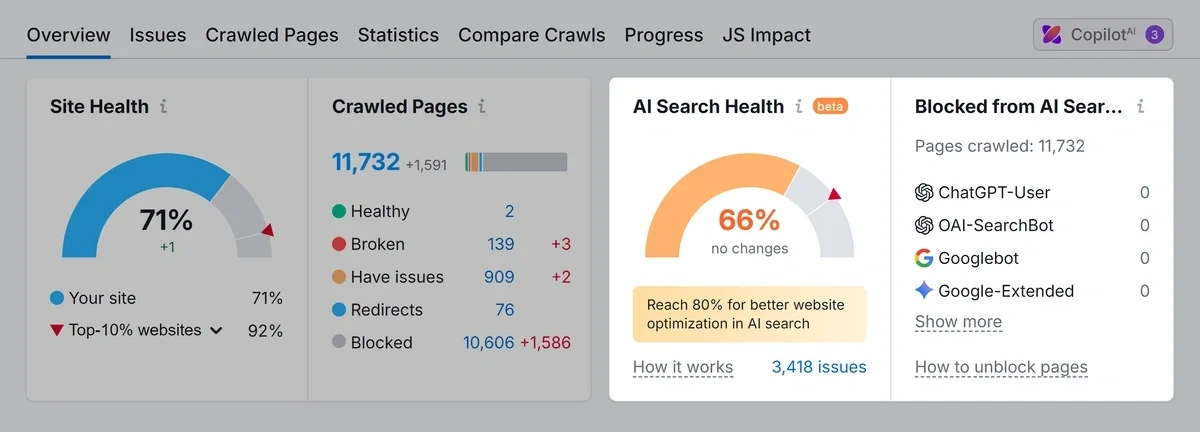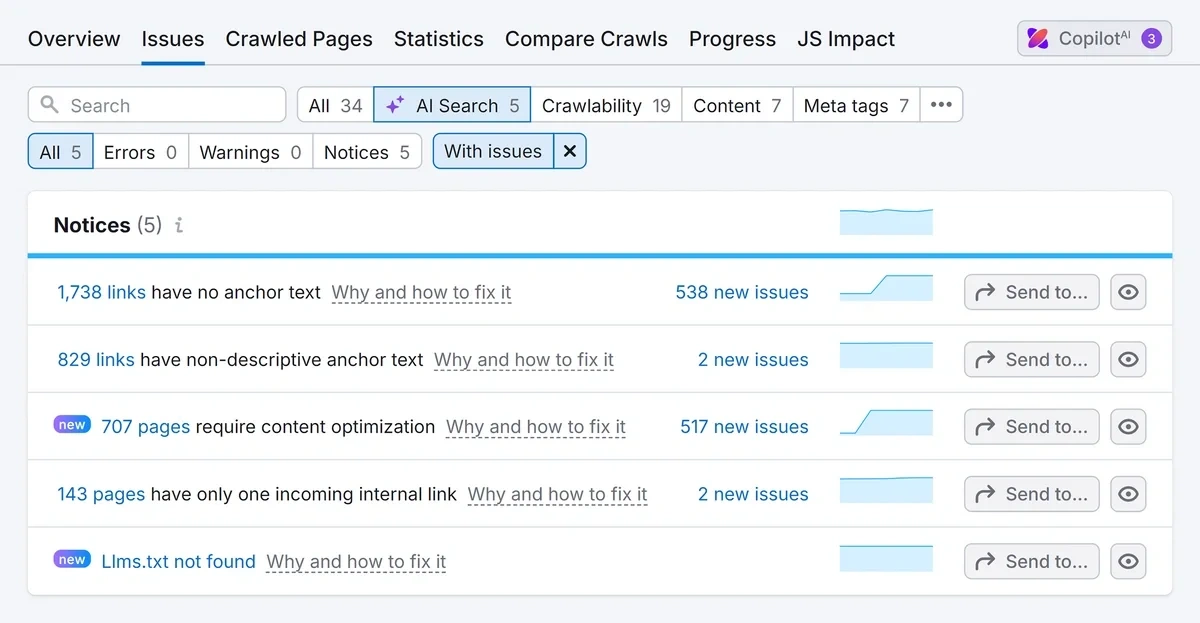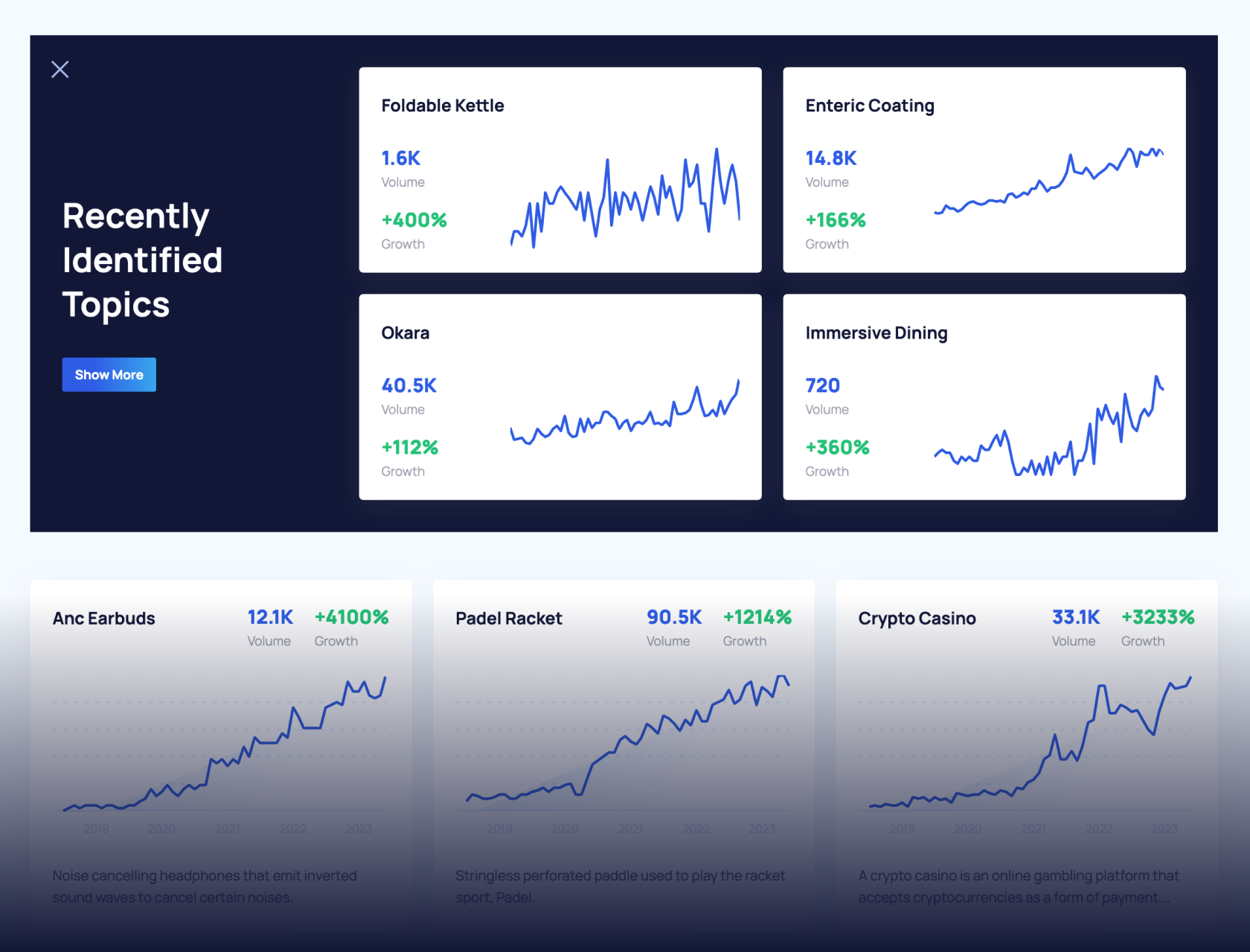
How I Use Semrush to Identify AI Visibility Opportunities
Optimizing for AI search is similar to plain old-fashioned SEO in many ways.
They both require smart tracking and analysis to create a strategy that works for you. Generic best practices usually won’t work.
That said, the metrics and data you need to make good decisions for your AI search performance are very different from those needed for traditional SEO.
In my experience, Semrush’s AI Visibility Toolkit provides the best insights for gauging your current standing and guiding your AI search strategy.
Let’s break down the practical steps you can take to win in AI search with the Semrush AI visibility analysis.
1. Analyze Current AI Visibility
The Visibility Overview is the perfect place to start analyzing any brand’s AI performance.
Type in a brand name and Semrush will give you a consolidated view of the brand’s visibility across popular AI models.
The AI visibility score indicates the frequency of your mentions in LLM answers. It also marks the industry average.
By default, the AI visibility score focuses on your overall performance across all AI platforms that the tool supports.
So a good score means you’re showing up frequently across all major AI surfaces. In modern SEO, that’s the ultimate goal.
A low overall score doesn’t mean your performance across every AI surface is bad. You could still be dominating AI answers in ChatGPT but underperforming in AI Mode, for instance.
Use the dropdown button at the top to select a specific AI model to track how well you’re doing there.
This is a great way to identify LLMs that prefer mentioning your brand more than other models do. Similarly, you’ll know which LLMs tend to overlook your brand.
These are valuable insights. A clear understanding of your strengths and weaknesses will set the foundation for your entire LLM optimization strategy.
The tool also breaks down raw metrics that make up your overall visibility:
- Monthly Audience: The volume of topics where your brand is mentioned in AI answers
- Mentions: The number of AI answers where your brand shows up.
- Cited Pages: Pages from your domain appearing as sources cited by LLMs.
These raw statistics are great for evaluating your performance with more specificity than just looking at the visibility score.
Essentially, it clarifies how much of your visibility is made of pure brand mentions, and how much is owed to your pages being cited in AI answers.
Identifying LLM-Relevant Topics and Opportunities
Moving further, you’ll find the single most helpful table that shows you relevant prompts where your brand is showing up.
I really like the topic-first approach.
That’s because no two prompts in an AI conversation are exactly the same. The variations between prompts associated with the same topic are too great.
It’s much easier to identify relevant prompts by wrapping up semantically related ones in a single topic instead.
And if you want to have a better idea of the prompts forming a topic, you can click the carrot button to reveal a representative set of prompts under a topic.
That way, you can determine the exact language that your audience is using during AI conversations relevant to your brand.
You’ll also be able to see if your brand was mentioned in the response to a tracked prompt.
If your brand isn’t being mentioned in relevant prompts, it will be labeled “Missed” in the Your Brand column.
I find it really helpful to filter this entire table for missed opportunities. Clicking the “Topic Opportunities” will update the table to show all the topics and prompts where your brand is currently missing.
You can view the full response for any prompt. It’s incredibly helpful when you have the full context of an answer and how AI is positioning the different brands appearing in the answer.
How to use this data in your content planning:
- Identify your best topics and carefully analyze your existing content on these topics. You can learn a lot about why AI is favoring your brand for certain topics by reviewing performing topics.
- Note AI messaging around your brand when you show up for a topic. Is it an enthusiastic recommendation or a half-hearted mention? Knowing this context will guide your strategy as you optimize content for LLMs.
- Identify your missed opportunities and topic gaps that you can cover by producing content for LLM visibility.
Owned Sources and Missed Source Opportunities
Besides prompts and topics, you’ll also find fantastic info about sources LLMs are using to generate responses to your brand-relevant prompts.
Move to the “Cited Sources” tab to find the top third-party sources. These are the domains that LLMs cite most frequently in answers where your brand appears.
Just like backlinks serve as off-site validation that Google uses to rank pages higher, AI visibility is strongly influenced by your brand’s presence on other websites.
Half the battle in off-page strategy is finding impactful domains that can make a big difference to your AI visibility.
This table helps you shortlist those domains so you can focus your digital PR on platforms that matter.
And if you’re looking to discover new opportunities for domains to target, switch to the “Source Opportunities” tab.
You’ll find a list of all domains that are producing great results for your competitors but not for you in AI answers.
How to use this data for your off-page strategy:
- Discover third-party platforms influencing your mentions and participate in conversations to maintain and boost your brand presence organically
- Find other third-party sites driving LLM mentions for competitors that you can either replace or share mentions with.
Top Cited AI-Cited Pages from Your Domain
LLMs depend on helpful, original content on the web to produce up-to-date answers that resolve a user’s query.
AI tools might be citing your pages when responding to certain prompts. It’s imperative to know what these pages are so you can maintain their quality for continued citation-worthiness.
The “Cited Page” tab of the table will bring up a list of these cited pages from your domain.
The next step? Prioritize these pages for content updates. If they’re decaying, make sure to freshen them up.
All AI tools like ChatGPT and Perplexity love fresh content when they’re referencing external sources.
At the same time, your pages need to have all the qualities of helpful content:
- High information gain so LLMs reference it for original data they can’t find anywhere else
- Demonstrate E-E-A-T so LLMs can trust the credibility and authoritativeness of your content
- Strong alignment with main intents and sub-intents to increase its citation potential across a wider set of AI queries.
2. Discover Competitive Gaps in AI Visibility
Studying competitors is one of the most fruitful exercises you can do as a marketer.
The Semrush AI Visibility toolkit has a competitor research feature that offers highly actionable data you can build your content strategy around.
You can enter a domain and up to 4 competitors to compare AI search performance against.
The tool shows you the AI visibility scores for your brand as well as your competitors. The chart updates every month, so you can track the visibility changes versus your rivals over time.
Once again, you can view the visibility metrics as an average of all tracked AI platforms, or filter by a specific AI model.
The data table is similar to the one in the Visibility Overview tool, but this one is more focused on what’s working for your competitors.
Perfect for spotting real gaps that can drive results for you too.
If you have used the Semrush Keyword Gap tool, this table might look familiar.
Just like Keyword Gap, you’ll find a list of topics and prompts that you and your rivals are competing to win visibility for.
The brand with the leading mentions for any topic is marked in green. Plus, you can find the volume estimate for each topic.
This helps you judge the relative importance of each topic.
The filter presets are super handy if you’re looking for specific opportunities, such as a list of topics where you aren’t mentioned yet but your competitors are.
It’s the same strategy from conventional SEO, where you find keyword ideas already producing great results for competitors.
The idea is to pick those same topics, do a better job of covering them than your rivals, and boost visibility.
In addition to topics, you can also perform this gap discovery for sources LLMs are citing when they mention your competitors, and how often.
It’s a good idea to use the different filters to view this information from different viewpoints. Here’s how the data changes depending on the applied filter:
- All: Removes all filters and shows you the complete dataset for sources relevant to your industry
- Missing: Only highlights sources where your competitors are present, but you are not
- Weak: Lists the sources where your competitors are mentioned more frequently than you
- Shared: Shows all sources that are shared between you and most competitors
- Strong: Focuses on sources where your brand presence is dominating
- Unique: Highlights sources that are unique only to your brand in AI mentions
These features are great for identifying areas where you’re stronger than competitors, as well as areas where you’re weaker.
A smart strategy is to maintain your performance where you’re already strong while focusing on your weaknesses to compete for additional visibility.
3. Research Topic Interest in AI Conversations
All SEO starts with keyword research (at least traditional SEO).
The same principle still stands in LLM optimization with one important difference: instead of keywords, you need to identify the right prompts.
The challenge is that you don’t know what your relevant audience might be typing into ChatGPT.
Every AI chat is personal, after all (at least until ChatGPT accidentally starts indexing private conversations).
The “Prompt Research” tool in Semrush is invaluable for this purpose. It illuminates a key blind spot to reveal the topics users are interested in when chatting with AI.
You’ll find a few familiar metrics here that are commonly also used in traditional keyword research.
For example, AI Volume indicates the interest in a topic. Use this to assess the demand a topic is seeing in AI conversations.
Semrush shows volume at the topic level rather than individual prompts.
I find this approach quite reasonable.
A prompt can have infinite variations. It’s just not possible to measure demand at so granular a level.
It’s much easier to analyze and compare volumes at the broader topic level.
The tool also reports Topic Difficulty, a metric similar to keyword difficulty. This helps you prioritize easier opportunities, offering the best chance of winning AI visibility.
The most useful part of the table is the list of prompt ideas related to your topic. These prompts reveal actual questions your users are asking.
Here are two ways you can use this data:
- For existing topics: Review whether you’re addressing the specific prompts related to the topic adequately.
- For new topics: Create content outlines better aligned with conversation patterns taking place in LLMs.
Apart from prompt ideas, the table also shows you the brands that are showing up in AI answers.
For every brand, the table shows you their visibility in the topic, total mentions, and the number of source domains contributing to the mention.
It’s a convenient feature that reveals the big picture about the brands competing for visibility for the topic in question.
The “Source Domain” tab highlights the top domains that LLMs are gathering info from when answering questions related to the topic.
This tool gives you the complete set of data to plan your content: clear demand signals for your topic, its difficulty level, example prompts, and third-party sites you should target to shape LLM responses.
4. Analyze AI Performance for Your Brand
The Semrush “Brand Performance” report lets you dive deeper into key aspects affecting your overall AI visibility.
The main part of this report is a chart displaying your Share of Voice and AI sentiment, plotted against your competitors.
Winning in AI answers as a brand is about showing up more often and with stronger prominence.
The Share of Voice measures your frequency of mentions in AI answers, along with how high you rank in lists where you and your rivals appear.
In other words, the stronger your Share of Voice, the more you stand out.
At the same time, it’s important to stand out for the right reasons. That’s why you need to keep an eye on your sentiment as well.
A good sentiment score indicates that your brand enjoys a positive portrayal in AI answers.
You’ll also find a breakdown of your overall sentiment and Share of Voice measured separately in individual charts.
Ideally, you want your representation to be overwhelmingly favorable, so it’s at least 70% of the sentiment in your favor.
Anything less than that and you’ll need to pinpoint the themes in AI answers when you’re spoken about negatively.
Similarly, the Share of Voice distribution allows you to see which brand has the bigger piece of the pie.
If a competitor is enjoying the majority of the share, it’s a good idea to analyze what’s working for them by using the “Visibility Overview” report again.
The last section of the report gives you fantastic information about specific attributes associated with brands in your industry.
Are you leading the mentions for particular themes in AI answers, or are you losing to competitors in those areas?
The Key Business Drivers by Frequency chart helps you understand your business’s strengths and weaknesses as perceived by LLMs.
This gets even better with competitor-wise breakdowns that compare your performance in specific business drivers against each rival, one by one.
You’ll likely discover that LLMs favor your rivals more when talking about certain qualities. It’s useful intel that allows you to think about your own business strategically.
For example, the Exploding Topics app leads overwhelmingly in AI conversations about tools with predictive forecasting features.
Knowing this, a competitor in this niche would want to develop similar features to steal some of the brand spotlight for itself.
And if a brand believes it already has that area covered well enough, then it’s a matter of improving content alignment with the themes of discussions in AI chats.
LLMs could be misrepresenting your brand if they can’t find enough information on your website and off-site validation to speak positively when certain attributes are mentioned.
This is what makes this feature so powerful. It’s not something that most other tools offer.
Finally, you can use AI-generated recommendations about next steps and actions you can take to fix the existing issues with your brand performance.
Since this is AI-generated, I recommend taking these with a grain of salt. That said, I’m extremely impressed with the quality of these insights and how precisely tailored they are to the brand.
The “Brand Performance” tool connects with several smaller tools for digging in deeper to individual aspects of your overall AI visibility.
Let’s take a look at these next.
5. Evaluate Brand Sentiment in AI Responses
The “Overall Sentiment” chart I discussed above connects with a dedicated report called “Perception”.
In this report, you can find a neat chart that tracks competitive perception by AI platform.
It’s as intuitive as it gets if you want to compare sentiments for each competitor across different AI models in a single chart.
To the left of your screen, you also have AI-generated insights, which is a feature that appears in all reports associated with “Brand Performance”.
The next section gives you two additional charts: overall sentiment and sentiment trends tracked over time.
It’s especially useful to track your trend when you have an active PR campaign underway, or when you’re publishing targeted content for AI visibility on your site.
It’s important to have a clear idea about your brand’s best aspects and weaknesses from the perspective of different LLMs.
The Key Sentiment Drivers section summarizes both your strengths and weaknesses.
Looking at your strengths is a pretty validating experience.
It shows that your hard work is paying off because AI wouldn’t be talking positively if you hadn’t done a good enough job positioning yourself well for these specific aspects of your brand.
Usually, this means LLMs have sufficient on-page trust and off-page confirmation to recommend your brand when certain brand themes come up in AI conversations.
Conversely, the areas of improvement highlight all the things where your messaging isn’t quite convincing enough for LLMs.
That’s not the only reason why your brand might be perceived negatively.
LLMs might also find unfavorable associations with certain features of your brand on social media or third-party platforms.
You’ll need a solid strategy that combines content with strong topic alignment and PR efforts to boost your portrayal outside of your website.
It’s a powerful way to influence the narrative AI is conjuring about your brand inside chats.
6. Measure AI Mentions and Citations
The “Narrative Drivers” report gives you a platform-focused chart for Share of Voice that shows how you measure up with your competition.
It’s quite handy when you want to see if your Share of Voice dominates in certain LLMs.
Or if your competitors are leading in some LLMs, you can then dive deeper by visiting their top-performing content and exploring why it’s successful.
This report also gives you a time-series chart for three important AI visibility metrics:
- Share of Voice
- Mentions
- Average position
- Ctiations
These charts are perfect for keeping track of improvements (or declines) in your AI search performance.
A detailed breakdown of this data is available in the form of a table at the bottom. This table shows you the prompts and your ranking in answers to those prompts.
The Visibility Overview and Competitor Research tools have similar tables, but this one has a different focus.
For example, you can swap the view in this table to look for non-branded or branded prompts. Plus, you can filter the table by your brand’s ranking position or your competitor’s.
The table also shows you information about cited domains that appear when your brand is mentioned.
It highlights the total citations you have from a domain, as well as the sentiment score at the domain level.
The fact that you can drill down to the page level makes this tool better than most other options on the market.
With data about specific pages contributing to your brand mentions and the sentiment associated with each page, you can make some solid decisions about platforms to prioritize for your off-page pitches.
Besides, a quick manual scan of the cited pages often reveals interesting patterns.
A high number of “how-to” guides appearing in citations is a clear indication that LLMs prefer pulling data from pages in these formats when you are included in answers.
Or if LLMs tend to cite UGC sites like LinkedIn in responses where your brand occurs, consider investing in LinkedIn thought leadership content for continued AI visibility.
The “Narrative Drivers” report makes it easy to glean action-driven insights like these.
7. Identify User Intent in AI Platforms
User intent is a lot more varied and precise in AI conversations compared to traditional Google search.
The “Questions” report helps you learn about the user intent behind popular prompt queries where you brand often appears.
First, you can see a map of broad topics in a colored grid representing themes underlying user queries.
Are people discovering you in AI by asking about features you offer and problems you solve, or are they more interested about your pricing?
With the Topic Distribution chart, you can learn which kinds of question themes are more popular.
This is super useful for planning your content and identifying topic themes and formats your audience is interested in.
The breakdown of intents and their evolution over time is another excellent feature.
If the intent patterns suggest that comparison content is more popular, then you need more comparison content.
Look at the intent distribution carefully to guide your content strategy.
Using the trend line, you can even predict if an intent is likely to stick around or if it’s fading.
In the example above, comparison-driven queries have a consistently horizontal line, indicating a continuing trend. There’s a noticeable rise in use cases recently as well.
From a strategic standpoint, it makes sense to produce more content focused on use cases to attract LLM visibility.
You can find a more detailed breakdown of the query distribution in the “Query Topics” section. This is helpful because it shows examples of prompts belonging to different intent groups.
8. Audit Your Site’s LLM-Friendliness
Optimized content increases your chances of showing up in LLM answers.
But this presupposes that your website has the correct technical foundations that allow LLMs to discover, consume, and understand your content in the first place.
The Semrush Site Audit tool can save you considerable time identifying and fixing issues with its updated AI-focused features for technical optimization.
The tool analyzes your AI Search Health separately from general Site Health. This way, you can focus on AI-specific issues easily.
For instance, you can see if your website is blocking any important AI search crawlers. It’s a simple issue to solve that just requires updating your robots.txt.
That said, it’s still incredibly handy to know if any bots are being clocked right away in the audit results.
When exploring specific issues that affect AI visibility, the AI search tab gives you a focused list of relevant issues.
These issues take into account several areas such as content structure, internal link, anchor text quality, and configuration files like llms.txt.
Basically, it’s everything you need to establish strong foundations for your website so that LLMs have an easier time pulling information.
Grow Your Presence Across AI Platforms
LLM optimization responds best to strategies that include owned content, third-party messaging and PR, and technical considerations.
I prefer Semrush as my tool of choice for improving AI search performance because it covers all three aspects exceedingly well.
The AI Visibility Toolkit data is effective for:
- Validating your existing content strategies and finding what’s working so you can double down
- Discovering missing opportunities for relevant prompts and citation sources that can boost your visibility
- Benchmarking industry performance and see how you stack up against key competitors
- Resolve technical issues to increase the chances of AI discovery and visibility in prompts that matter.
Stop Guessing, Start Growing 🚀
Use real-time topic data to create content that resonates and brings results.
Exploding Topics is owned by Semrush. Our mission is to provide accurate data and expert insights on emerging trends. Unless otherwise noted, this page’s content was written by either an employee or a paid contractor of Semrush Inc.
Share
Newsletter Signup
By clicking “Subscribe” you agree to Semrush Privacy Policy and consent to Semrush using your contact data for newsletter purposes
Written By


Osama is an experienced writer and SEO strategist at Exploding Topics. He brings over 8 years of digital marketing experience, spe... Read more

